Verification of the effect of AZOTER F soil bacterial preparation and AZOTER L foliar bacterial fertilizer in the plant stand of winter wheat and maize for silage

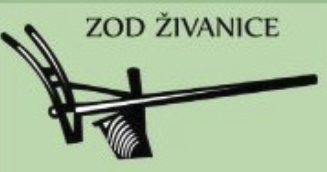

Report on results from semi-operational experiments from 2019
* * *
Ing. Tomáš Javor, DiS., Ing. Lenka Beranová, DiS. a kol., AGROEKO Žamberk spol. s r.o.
Petr Junek, Podorlické zemědělské družstvo Ohnišov (winter wheat)
Jan Podaný, Zemědělské obchodní družstvo „Bratranců Veverkových“ Živanice (maize)
Jiří Řezníček, AZOTER CZ s.r.o.
Winter wheat in the territory of Ohnišov (o. Rychnov nad Kněžnou)
Soil characteristics: medium heavy to heavy (Cambisol leptic, Cambisol pelic) on solid marlstone sediments, 346 m above the sea level.
| Soil | Content of the nutrients Obsah přístupných živin (mg/kg soil) | ||||
| pH/CaCl2 | P | K | Ca | Mg | S |
| 6,28 | 103 | 164 | 2863 | 230 | 23 |
| Slightly acidic | Good | Satisfactory | Good | Good | Satisfactory |
Table 1. Agrochemical soil properties on the site before AZOTER products application (14. 9. 2018)
AZOTER F bacterial fertilizer was applied on September 28, 2018, before sowing the wheat. The product was sprayed directly on the surface of the soil and then incorporated into the soil using a compactor to a depth of 5 – 6 cm. The spring AZOTER L fertilizer was applied with a sprayer at the end of rooting on 10 April 2019. A stand of Patras variety was established using conventional plowing technology. The harvest took place on July 26, 2019.
AZOTER bacterial fertilizers were applied in a system of applied nitrogen saving with mineral fertilizers. Nitrogen in mineral fertilizers was applied directly to the control plots with a standard total dose of 190 kg / ha. In the other control plot, additional phosphorus was applied at a dose of 80 kg P2O5 / ha and potassium at a dose of 47 kg K2O / ha. During the first half of the vegetation, the plants responded positively to application of phosphorus (in stem elongation) with an average of 63% higher dry matter weight of plants. Phosphorus promoted root branching, faster spring regeneration and more intensive rooting. This effect subsequently decreased a lot. The plants slowed their growth and the weight of aboveground biomass at the early maturity was 26% lower than at the control without phosphorus and potassium application. After the application of AZOTER F bacterial preparation to the soil before sowing, only 110 kg N / ha was applied, so the dose was reduced by 80 kg N / ha. However, despite the significant nitrogen savings in mineral fertilizers, the plants showed increasement by 18% of aboveground biomass weight in stem elongation. Later it was 7% higher in early maturity than at the control. Application of only foliar bacterial fertilizer AZOTER L in rooting significantly improved the growth during the stem elongation period. The plants showed a 59% higher weight of aboveground biomass, mainly due to more intensive rooting ability. In this variant, however, growth slowed down in the second half of the vegetation, despite the application of a full dose of 150 kg N / ha in mineral fertilizers. The plants showed 24% less weight during the early maturity period than in the control. Combining the application of AZOTER F (to the soil before sowing) and AZOTER L (in the spring in rooting) had a positive effect on the faster growth of aboveground biomass in the first half of the vegetation (until stem elongation period). At this time the plants showed 44% higher weight than in the control.
Only 70 kg N / ha was applied in mineral fertilizers to this combination. It was reflected in the second half of the vegetation by 21% decrease in the weight of aboveground biomass compared to the control. An immediate effect was after the application of L Variant. In the stem elongation, the plants showed 18% higher weight of aboveground biomass.Subsequently, the effects of AZOTER L application and the effect of AZOTER F in the soil decreased and the plants showed 30% lower increase of aboveground biomass compared to the control. In this variant, nitrogen was not used in mineral fertilizers. Regarding the nitrogen savings in mineral fertilizers, a variant of 80 kg / ha seemed to be suitable, in other words, application of only 110 kg N / ha after previous application of AZOTER F bacterial fertilizer before sowing into the soil (Graph 1).
Graph 1. Influence of the application of AZOTER fertilizers on the dry matter weight of aboveground biomass of wheat plants at the beginning of stem elongation (BBCH 30-31) and early maturity (BBCH 71).
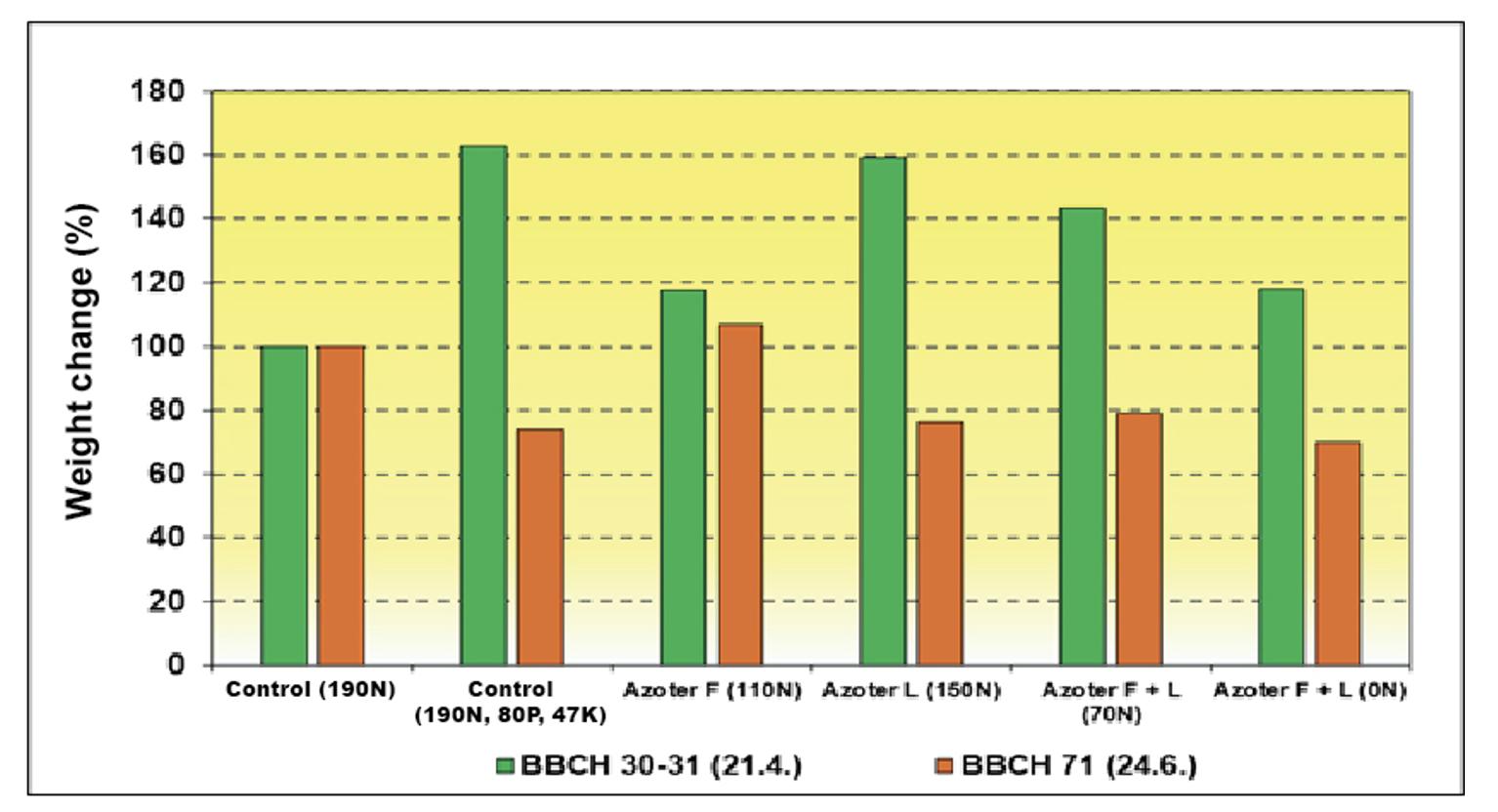
The nutritional status of plants for the expected grain yield was different, especially at the end of the vegetation. At the beginning of spring vegetation in stem elongation (BBCH 30-31) the best nutritional status (N, P, K, Ca and Mg) of the plants was found in the control where the NPK fertilizer was applied before sowing. The second-best nutritional status was found after the foliar application of AZOTER L fertilizer in the rooting. Third best nutritional status was found after applying AZOTER F before sowing in combination with AZOTER L during vegetation period with the addition of 70 kg N / ha in mineral fertilizers and comparably after application of only AZOTER F with the addition of 110 kg N / ha. Close to these variants the nutritional status of plants was at the control with the application of a full dose of nitrogen of 190 kg / ha without the application of AZOTER preparations. The worst nutritional status, although with a minimal difference from the previous positions, was on the „ecological“ variant without the application of mineral fertilizers, where the nutrition was provided only with the combination of AZOTER F and AZOTER L application.
During the period of early maturity of the grain (BBCH 71), the nutritional status of plants with nitrogen, potassium and calcium was very different in individual variants. Phosphorus and magnesium nutrition was more balanced in the variants, but the condition was slightly better at the control where a full nitrogen dose of 190 kg N / ha was applied. An exception to the treated variants of the tested preparations was the application of AZOTER F before sowing. It showed the best nutritional status of phosphorus from the treated variants. The best nitrogen and potassium nutrition was at the control variant with a full dose of N fertilization of 190 kg / ha. The second-best and very close to the high fertilization control was the nutritional status after the application of AZOTER F before sowing and with the spring application of 110 kg N / ha in fertilizers. Third best nutritional status with nitrogen and potassium was after the application of NPK fertilizer at the other control variant with a full dose of 190 kg N / ha. Fourth best nutritional status with nitrogen and potassium was at the end of the vegetation period after the application of AZOTER L in rooting and with the spring application of 150 kg N / ha. The worst nitrogen and potassium nutritional status were after AZOTER F application before sowing in combination with AZOTER L in rooting with the addition of 70 kg N / ha. Comparably the same was on the variant without the addition of nitrogen in fertilizers. To sum up, after the application of the tested preparations, the best nutritional status was after the basic application of AZOTER F before sowing with the addition of 110 kg N / ha during the vegetation period (Graph 2).
At the end of vegetation period, the number of shoots per plants were significantly reduced on AZOTER F treated variants in combination with AZOTER L (with addition of 70 kg N / ha and without addition), after AZOTER L application (with addition of 150 kg N / ha) and after application of NPK fertilizer at the control before sowing. Fertile shoots were at the end of the vegetation. With the occurrence of extreme drought, they were mostly preserved on the plants at the control with a full nitrogen dose of 190 kg / ha and after AZOTER F application before sowing with nitrogen application of 110 kg / ha.
Graph 2. Comparison of nutritional status of plants with nitrogen, phosphorus, potassium, calcium, and magnesium for the model grain yield in the period of stem elongation (BBCH 30-31) and at the end of vegetation in the early maturity of grain (BBCH 71)
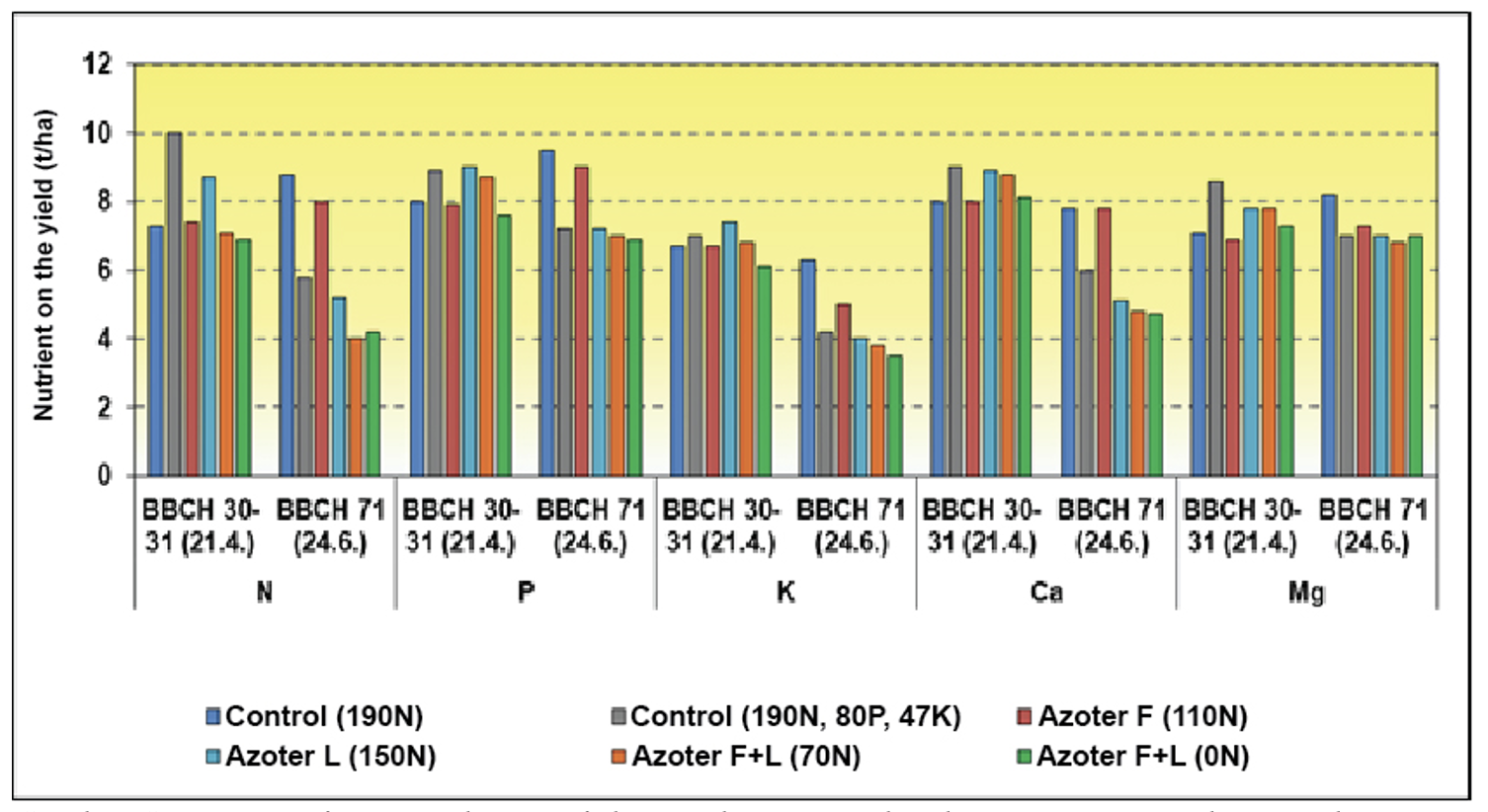
| Average number of shoots per plants in the monitored period according to variant treatment | ||||||
| Period | Control (190N) | Control (190N,80P,47K) | AZOTER F (110N) | AZOTER L (150N) | AZOTER F+L (70N) | AZOTER F+L (0N) |
| BBCH 30-31 (stem elongation) 21.4. | 1,7 | 3,4 | 2,1 | 2,5 | 1,8 | 3,0 |
| BBCH 71 (early maturity) 24.6. |
1,4 | 0,4 | 1,1 | 0,5 | 0,5 | 0,4 |
| Overall vegetation | 1,6 | 1,9 | 1,6 | 1,5 | 1,2 | 1,7 |
In more detail, the plants received a total amount of 174 kg / ha of the main nutrients (N, P, K, Ca and Mg) at the fully fertilized control during the stem elongation period (BBCH 30-31). Nitrogen intake was 85 kg, phosphorus intake was 9.6 kg and potassium intake was 67 kg / ha. At the control No. 2 with phosphorus and potassium application, the plants received a total amount of 297 kg of nutrients per 1 ha. Nitrogen intake was 153 kg, phosphorus intake was 14.9 kg and potassium intake was 107 kg / ha. After application of AZOTER F to the soil before sowing the wheat, the plants received 200 kg of nutrients per 1 ha during the starting period of stem elongation. Nitrogen intake was 97 kg, phosphorus intake was 10.8 kg and potassium intake was 77 kg / ha. After AZOTER L application in rooting, the plants were stimulated to grow and received 278 kg of nutrients per 1 ha. Nitrogen intake was 129 kg, phosphorus intake was 15 kg and potassium intake was 113 kg / ha. After AZOTER F application before sowing in combination with AZOTER L in rooting with 70 kg N / ha in fertilizers, the plants received a total amount of 232 kg of nutrients per 1 ha, of which 106 kg of N, 13.2 kg of P and 95 kg of K / ha. After application of the preparations without the addition of N fertilizers, the plants received 190 kg of nutrients per 1 ha in stem elongation, of which 91 kg of N, 10.3 kg of P and 74 kg of K / ha. The results of nutrient intake in the period of the first half of the vegetation (until stem elongation period) showed a positive effect of bacterial preparations and fertilizers on the growth and nutritional status of wheat crops. Stimulation of the plants was very good immediately after the application of the AZOTER L foliar fertilizer, applied in rooting (Graph 3).
Graph 3. Biological nutrient intake of aboveground biomass of wheat in the stem elongation period (BBCH 30-31) on 21 April 2019
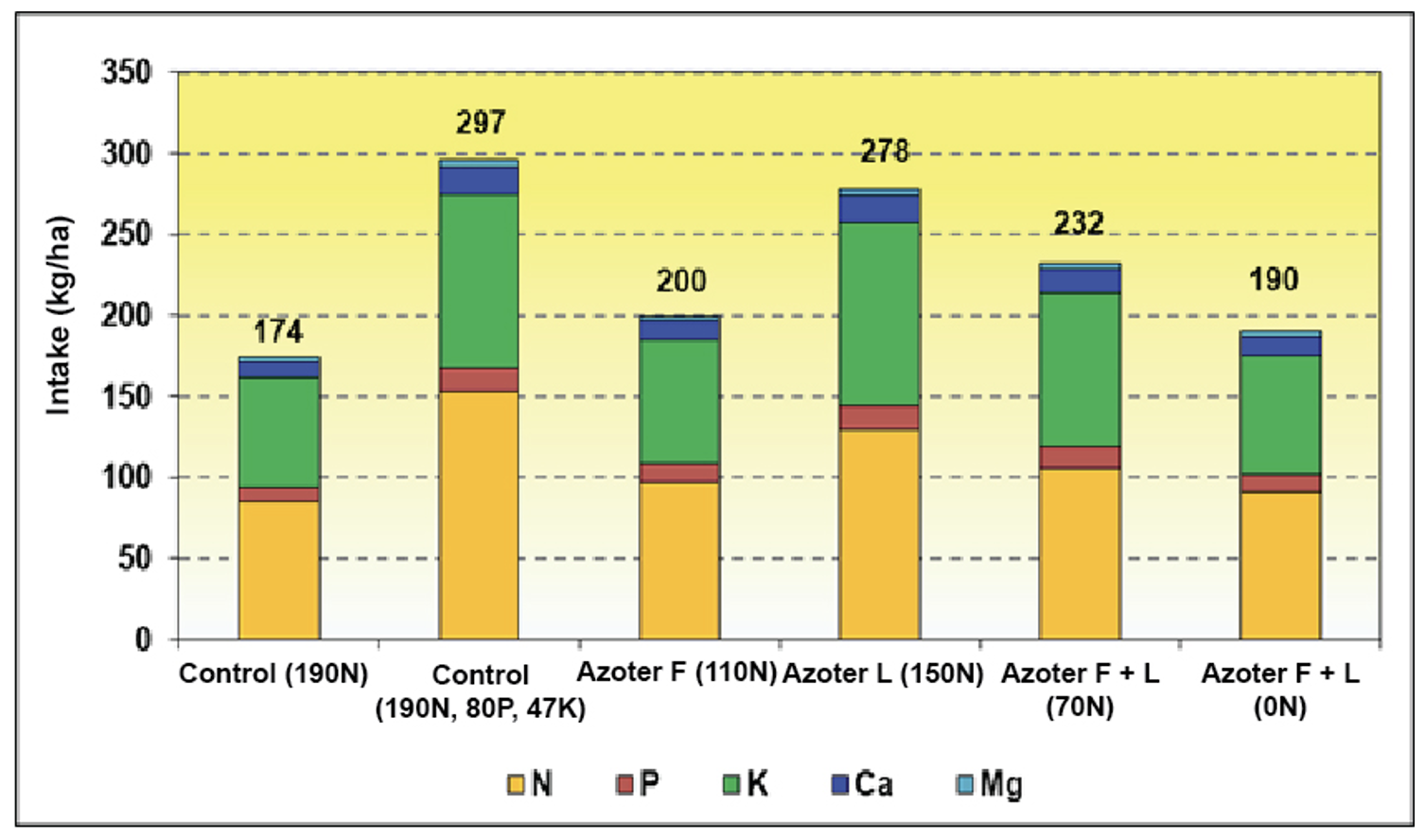
According to the individual variants of fertilization and stimulation of plants, the trend of nutrient intake in the second half of vegetation changed significantly compared to the state in stem elongation period. During the period of early maturity of grain, the plant stands at the control variant received a total of 728 kg of main nutrients from 1 ha.Nitrogen intake was 325 kg, phosphorus intake was 46 kg and potassium intake was 294 kg / ha. At the control plot with the additional application of phosphorus and potassium, the plants received significantly less nutrients, a total of 392 kg / ha. Nitrogen intake was 185 kg, phosphorus intake was 26 kg and potassium intake was 143 kg / ha. After AZOTER F application to the soil before sowing, there was a nutrient intake of an average of 643 kg / ha. In more detail, intake of nitrogen was 305 kg, intake of phosphorus was 39 kg and intake of potassium was 234 kg / ha. The effect of AZOTER L application stagnated and nutrient intake reached only 370 kg / ha at the end of vegetation period. Nitrogen intake was 177 kg, phosphorus intake was 26kg and potassium intake was 135 kg / ha. After AZOTER F application before sowing in combination with AZOTER L in rooting with the addition of 70 kg N / ha in mineral fertilizers, the plants received 317 kg of nutrients per 1 ha (141 kg N, 25 kg P, 120 kg K / ha). Applying AZOTER F before sowing in combination with AZOTER L in rooting without the addition of nitrogen in fertilizers showed a total nutrient intake of 291 kg / ha. Nitrogen intake was 137 kg, phosphorus 23 kg and potassium 103 kg / ha. NPK fertilization into the seedbed showed a reduction in the growth ability of the roots into a deeper soil profile, which resulted in the significant reduction of nutrient intake.Regarding the tested products, AZOTER F application supported the plant growth and nutrition more effectively, but full nitrogen fertilization up to 190 kg N / ha without AZOTER application (control) showed the highest nutrient intake (Graph 4).
Graph 4. Biological nutrient intake by aboveground biomass of wheat during early maturity (BBCH 71) on 24 June 2019
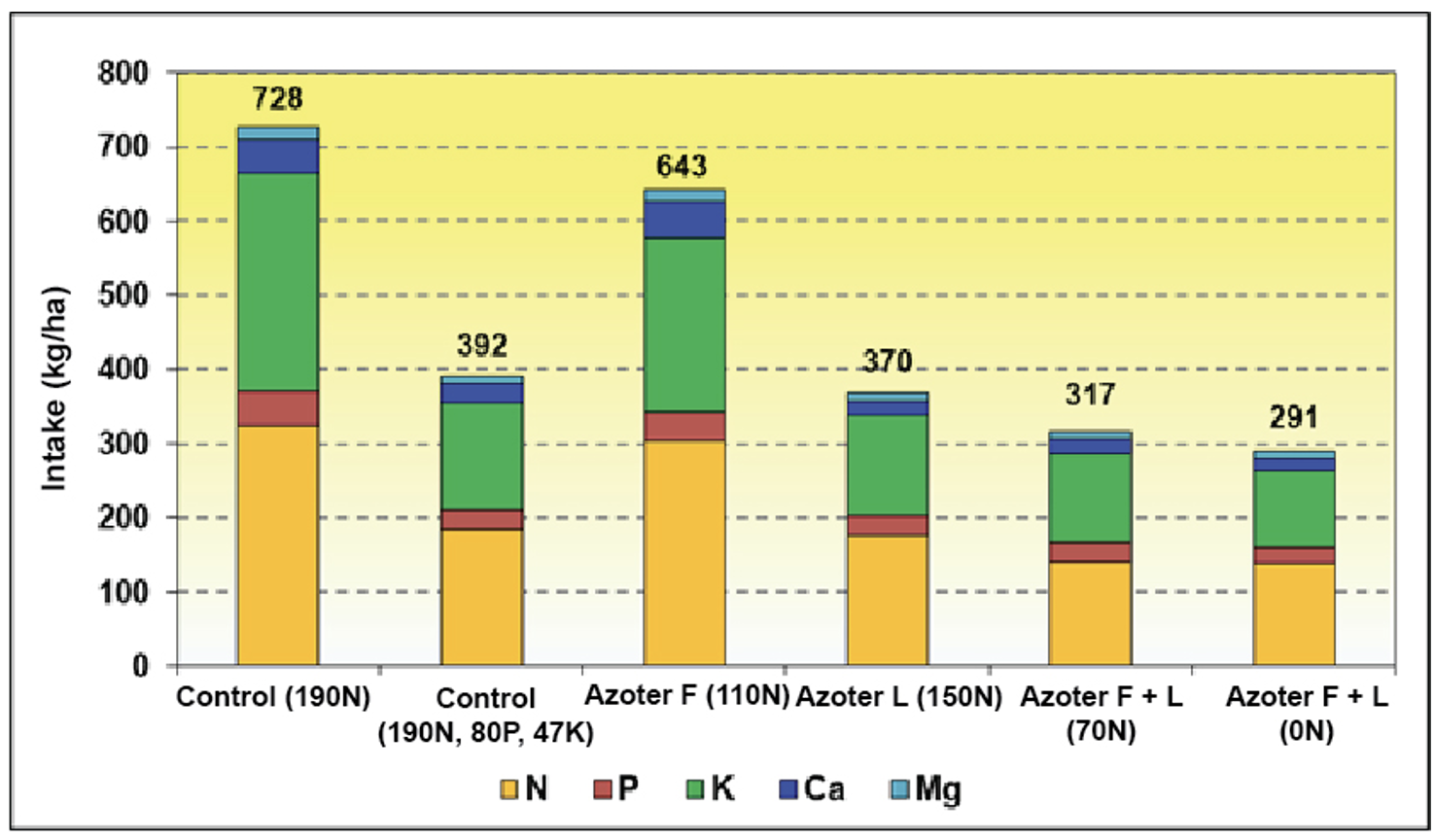
The soil under the plant stands showed a significantly lower content of mineral nitrogen (Nmin.) during the early maturity period than in the autumn before the experiment started. Prior to the establishment of the plant stands and AZOTER F application, a sufficient supply of Nmin was found after dry weather period. In the summer 2019, in the period when the major demand of nitrogen in wheat was finishing, a low supply of Nmin was recorded at the control variant and on the variants treated with AZOTER application. A very low supply was found on the variant without nitrogen application in fertilizers. Insufficient supply of Nmin. for grain quality formation was on the variants with the combination of AZOTER F application before sowing and subsequent application of AZOTER L in rooting, without the addition of nitrogen (0 kg N / ha) even at a lower dose of nitrogen in fertilizers of 70 kg N / ha. The mean demand for nitrogen fertilization was diagnosed for other variants, including the control (Table 2).
| Date of sampling | Variant treatment | Dry matter (%) | N-NO3 (mg/kg) | N-NH4 (mg/kg) | Nmin. (mg/kg) | Supply (category) | Supply (kg/ha) |
| 14.9.2018 | Exeriment area | 88,55 | 20,90 | 2,97 | 23,84 | Good | 95 |
| 24.6.2019 | Control (190N,80P,47K) | 87,67 | 4,05 | 4,38 | 8,43 | Low | 34 |
| AZOTER F (110N) | 87,03 | 4,08 | 3,44 | 7,52 | Low | 30 | |
| AZOTER L (150N) | 87,92 | 4,37 | 5,02 | 9,39 | Low | 38 | |
| AZOTER F + L (70N) | 86,16 | 1,85 | 3,54 | 5,38 | Low | 22 | |
| AZOTER F + L (0N) | 86,84 | 1,83 | 3,11 | 4,94 | Very low | 20 |
Table 2. Content of mineral nitrogen (Nmin.) in the soil before the experiment and in the summer during the early maturity of wheat.
Crop plot area after AZOTER F application before pre-sowing preparation (drought, October 17, 2018)
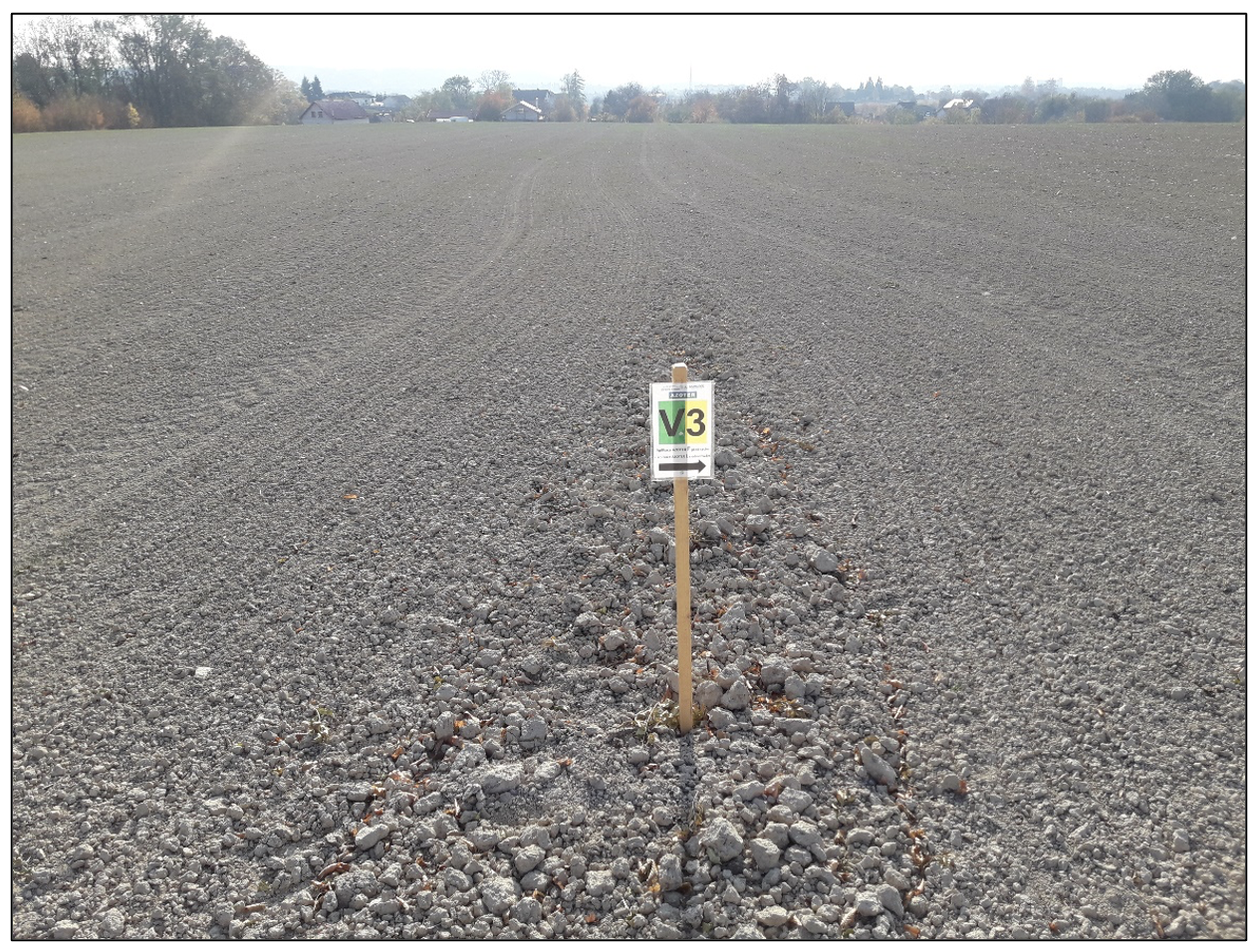
The harvest yield of the grain varied according to individual variants from -20 to + 1% compared to the control where the application of tested AZOTER preparations was not performed. The grain yield of 7.44 t / ha was found at the first control plot with a full dose of nitrogen fertilization of 190 kg / ha. On the other control variant with the additional application of NPK fertilizer before sowing (supply of P and K for wheat stand), a yield of 7.14 t / ha was achieved. In the dry course of the vegetation, application of phosphorus and its deep ploughing into the seedbed resulted in poorer use of moisture of plants with shallower rooting in the soil surface profile, into which the low-mobility phosphorus was ploughing in before sowing. In dry summers, the application of phosphorus in the surface layer is common. After application of the tested AZOTER F preparation into the soil before sowing followed by spring application of a reduced nitrogen dose to 110 kg / ha, the highest grain yield of 7.52 t / ha was found.
The application of the bacterial preparation provided soil with enough nitrogen (it supplemented the saving from mineral fertilizer application) and phosphorus and potassium. After AZOTER L application in rooting and spring application of a reduced dose of nitrogen to 150 kg / ha, the growth of the yield reached 7.02 t / ha. After applying AZOTER F before sowing in combination with AZOTER L in the spring in rooting and after applying a significantly reduced nitrogen dose to 70 kg / ha, a grain yield of 6.47 t / ha was achieved. After applying AZOTER F in combination with AZOTER L and without the use of nitrogen fertilizers (0 kg N / ha), the lowest grain yield of 5.96 t / ha was achieved (Graph 5).
The grain yield according to the individual variants corresponded to nitrogen consumption. At the highest levels of yield in the experiment, close to control variants with full nitrogen fertilization in a dose of 190 kg / ha and after applying AZOTER F to the soil before sowing with a reduced spring application dose of nitrogen to 110 kg / ha, plant stands harvested comparably around 22 kg N / t yield. This was in the interval of a standard medium nitrogen uptake of wheat grain. After AZOTER L application in a spring dose of 150 kg N / ha, the plant stand has already taken less than 19.4 kg N / t, after applying AZOTER F before sowing in combination with AZOTER L in rooting and with the addition of 70 kg N / ha in fertilizers the plant stand took 18 7 kg N / t. Significantly lower nitrogen uptake of 15.5 kg N / t was after applying the combination of AZOTER preparations without nitrogen fertilizer. The yield without nitrogen fertilization, ie nitrogen nutrition was provided only by applying AZOTER products and mineralization process in the soil, ensured a yield of 5.96 t / ha even in dry weather.
Graph 5. Effect of AZOTER application on wheat grain yield (at 14% humidity)
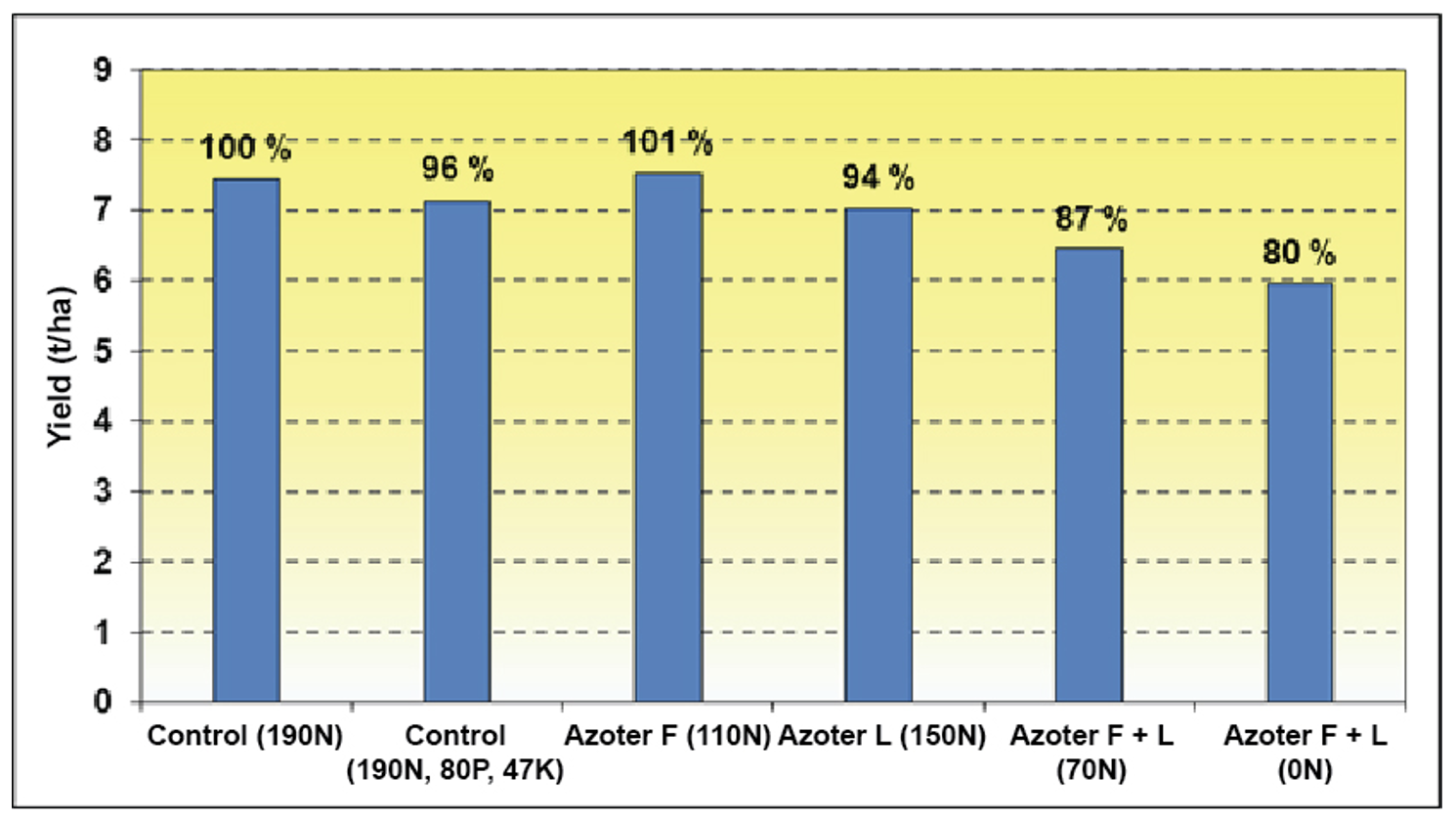
| Nitrogen uptake by wheat grain in harvest | ||||||
| Uptake | Control (190N) | Control (190N,80P,47K) | AZOTER F (110N) | AZOTER L (150N) | AZOTER F+L (70N) | AZOTER F+L (0N) |
| kg N/ha: | 146 | 139 | 144 | 112 | 117 | 82 |
| kg N/t: | 22,3 | 22,1 | 21,6 | 19,4 | 18,7 | 15,5 |
The highest grain yield on the variant with AZOTER F application and with the spring application of the adjusted nitrogen dose to 110 kg / ha was formed by a higher number of ears and a higher number of grains in the ear. The thousand grain weight (TGW) was average, the bulk density was medium. Control variants without applying AZOTER preparations with a full dose of nitrogen showed the highest number of ears, but lower thousand grain weight and lower bulk density of grain. Applying AZOTER F before sowing in combination with AZOTER L for leaf in rooting had the greatest effect on the grain size when the level of nitrogen fertilizer application was lower. This indicated a gradual and intensive effect of bacterial fertilizers on nutrient intake at the end of dry vegetation (Table 3).
| Treatment | No. of ears (ks/m2) | HTZ (g) | Bulk density of grain (dg/l) |
| Control (190N) | 643 | 39,49 | 73,6 |
| Control (190N,80P,47K) | 684 | 39,71 | 72,6 |
| Azoter F (110N) | 636 | 40,73 | 75,3 |
| Azoter L (150N) | 592 | 40,14 | 73,5 |
| Azoter F + L (70N) | 572 | 46,33 | 77,0 |
| Azoter F + L (0N) | 572 | 43,45 | 74,4 |
Table 3. Influence of AZOTER products on selected yield-generating elements
Quality of grain according to nitrogen content (NL) decreased with the intensity of nitrogen fertilizer during spring vegetation. The highest NL content of 13.9% was at the control plots with a full nitrogen dose of 190 kg N / ha. After applying 18 kg N / ha in autumn in NPK fertilizer and the remaining parts of 172 kg N / ha in spring, the NL content decreased slightly to 13.8%. After applying AZOTER F before sowing with a reduced dose to 110 kg N / ha, the NL content was still high at 13.5%. After applying AZOTER L with a spring dose of 150 kg N / ha in fertilizers, the NL content was already lower than 12.1%. Here, the limit of the usual minimum requirement for the NL content of 12.5% in grain for bakery processing wasn´t reached. After applying AZOTER F before sowing and subsequently AZOTER L in rooting with the addition of 70 kg N / ha in fertilizers, the NL content decreased to 11.7%. A significant decrease in the NL content to 9.7% was found without the addition of nitrogen in technological combination of AZOTER F and AZOTER L application.
The lowest starch content was on the control variants and the highest on the plot without the use of nitrogen fertilizer. The trend corresponded to the content of nitrogenous substances in the grain. The falling number (FN) of 520 swas the highest one on the control variant and the lowest FN of 443 s was on the plot without the use of nitrogen fertilizer with applying the combination of AZOTER F + AZOTER L. The most profitable variant after applying AZOTER F with the addition of 110 kg N / ha in fertilizers showed the second highest falling number of 488 s. Applying AZOTER L with 150 kg N / ha in fertilizers showed a falling number of 483 s. The application of NPK fertilizer before sowing was reflected at least in the falling number (468 s). The combination of AZOTER F before sowing and AZOTER L in rooting with addition of 70 kg N / ha showed a falling number of 451 s. Falling values for dry vegetation were very high on all variants, which indicated very good starch stability and good protein content in bread processing.
The content of wet gluten was the highest – it represented 29% after applying NPK fertilizer on the control with a full dose of 190 kg N / ha and without AZOTER application, then after AZOTER F application with addition of 110 kg N / ha and on the control with a full dose of 190 kg N / ha without NPK application in the autumn. It is evident that plants that were more intensively fertilized and nourished provided the highest gluten content. After applying AZOTER L with addition of 150 kg N / ha, the gluten content was lower 26% and after applying the combination of AZOTER F + AZOTER L with addition of 70 kg N / ha, the gluten content decreased to 25%. Without applying N fertilizers after the use of AZOTER F + AZOTER L combination, the lowest gluten content of 18% was found. The quality of gluten according to the gluten index indicator was the highest of 94% with its low content on the variant of AZOTER F + AZOTER L combination without nitrogen fertilizer application. The lowest quality of gluten 76% was found after applying AZOTER F with addition of 110 kg N / ha. After application of the full dose of nitrogen on controls without AZOTER application, the gluten index was medium, between 81-85%.
Zeleny sedimentation test was mostly high, except for the variant after applying the combination of AZOTER F before sowing and AZOTER L in rooting without nitrogen fertilizer addition ((0 kg N / ha), where the volume of sediment was small 26 ml. Application of full nitrogen dose of 190 kg N / ha (control) showed the highest volume of sediment 55 ml and similarly the other control with NPK fertilizer application at full nitrogen dose showed the sediment volume of 50 ml. The most profitable variant treatment with AZOTER F application and with the spring addition of 110 kg N / ha in fertilizers also showed a higher sediment volume of 45 ml. The medium sediment volume of 40 ml was after applying AZOTER L with addition of 150 kg N / ha and after the combination of AZOTER F + AZOTER L with addition of 70 kg N / ha (Table 4).
| Treatment | Content of
N-substances (%) |
Starch contentu (%) | Decrease
no. u (s) |
Content of wet gluten (%) | Gluten index (%) | Zeleny sediment. test (ml) |
| Control (190N) | 13,92 | 64,06 | 520 | 28,8 | 85 | 55 |
| Control (190N,80P,47K) | 13,80 | 64,81 | 468 | 29,5 | 81 | 50 |
| Azoter F (110N) | 13,52 | 64,94 | 488 | 29,1 | 76 | 45 |
| Azoter L (150N) | 12,12 | 67,44 | 483 | 25,6 | 84 | 40 |
| Azoter F + L (70N) | 11,67 | 68,00 | 451 | 24,8 | 83 | 40 |
| Azoter F + L (0N) | 9,70 | 71,63 | 443 | 18,0 | 94 | 26 |
Table 4. Influence of AZOTER products on wheat grain quality
Economic evaluation: Application of AZOTER bacterial fertilizers had a very positive effect in F-type variant applied into the soil before sowing. AZOTER F application with a saving of 80 kg N / ha in the spring application of nitrogen fertilizers (only 110 kg N / ha) showed only a slight, by 1% higher grain yield than the experiment control, but there was 2.3% increase in net sales. That is an increase by CZK 652 / ha compared to the control with a full dose of 190 kg N / ha. The increase in sales consisted of both higher gross sales by CZK 312 / ha and, primarily, the economic efficiency (savings) in amount of CZK 1.440 / ha on nitrogen applied in fertilizers compared to the control with a full dose of nitrogen. Nitrogen fertilizer savings were higher than the costs for AZOTER F application (average price for the product is 900 CZK + usual price of spray application 200 CZK / ha). To reduce the spring inputs of fertilization of the plant stand, the savings can be calculated by CZK 200,00 higher. In total, it´s in amount of CZK 1,640 / ha. The second highest net sales were achieved on control plot. The third place took the net sales after the application of AZOTER L in the rooting, with the saving of 40 kg N / ha compared to the control. However, it showed a decrease by 7% compared to the control with a full nitrogen dose of 190 kg N / ha and without AZOTER application. The drop in sales by 11% was after applying NPK fertilizer on the other control variant with a full dose of nitrogen of 190 kg / ha. Applying the combination of AZOTER F before sowing + AZOTER L in rooting and with addition of 70 kg N / ha showed 13% loss of sales. The following variant without addition of nitrogen in fertilizers showed almost 16% loss of sales compared to the control.
Graph 6. Comparison of net sales from wheat production according to different rate of fertilization and application of AZOTER products
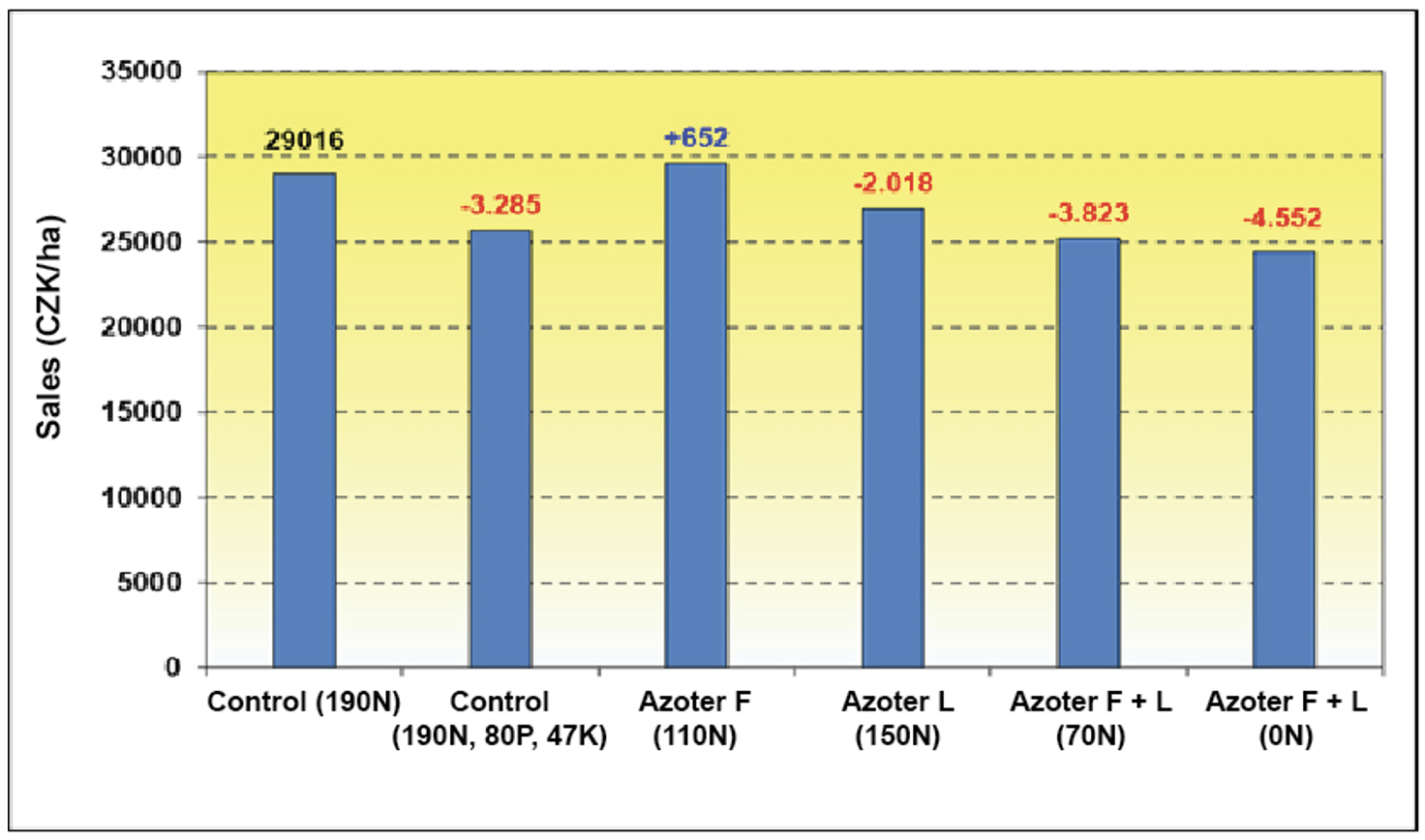
Note: Net sales = direct gross sales (CZK 3.900 / t of grain) after deduction of direct fertilization costs performed beyond the control variant (190N), ie after deduction of the costs for phosphorus and potassium application (variant 190N, 80P, 47K) and after deduction of the costs for the application of AZOTER products in the overview of the individual variants. Net sales also include savings in nitrogen fertilization (1 kg N = CZK 18) for variants where AZOTER products are applied.
| Treatment | Gross sales (CZK/ha) | Direct costs for crop fertilization | |||
| Application of fertilizer (CZK/ha) | AZOTER application (CZK/ha) | Application total (CZK/ha) | Total per 1 t of grain (CZK) | ||
| Control (190N) | 29016 | 3420 | 0 | 3420 | 460 |
| Control (190N,80P,47K) | 27846 | 5175 | 0 | 5175 | 725 |
| Azoter F (110N) | 29328 | 1980 | 1100 | 3080 | 410 |
| Azoter L (150N) | 27378 | 2700 | 1100 | 3800 | 541 |
| Azoter F + L (70N) | 25233 | 1260 | 2200 | 3460 | 535 |
| Azoter F + L (0N) | 23244 | 0 | 2200 | 2200 | 369 |
Maize for silage in the territory of Živanice (o. Pardubice)
Soil characteristics: medium heavy to lighter (modal fluvisols eubasic to mesobasic, fluvisols cambic) on alluvial sediments, terraces, 212 m above the sea level
| Organicmatter (%) | Soil PH re | Available nutrient content (mg/kg of soil) | |||||
| Cox. | pH/CaCl2 | Nmin. | P | K | Ca | Mg | Zn |
| 1,39 | 6,49 | 10,8 | 70 | 113 | 4062 | 214 | 0,57 |
| Medium | Slightly acidic | Low content | Acceptable | Acceptable | High | Good | Low |
Table 5. Agrochemical soil properties on the site before AZOTER products application (4. 4. 2019)
The application of the AZOTER F bacterial fertilizer was performed before sowing maize on 15 April with a common type of ground sprayer incorporated into the soil using a compactor to a depth of 8 – 10 cm. After, liquid nitrogen DAM 390 fertilizer was applied. The application of AZOTER L was carried out during the vegetation on 20 June in the period of the developed 7th – 8th leaf of maize. The variety P9400 was grown. The harvest was on September 20, 2019.
During the period of intensive maize growth, the soil showed the highest supply of mineral nitrogen (Nmin.) at the control plots without AZOTER fertilizer application, only with the application of the full dose of nitrogen in fertilizers. A sufficient supply of Nmin was diagnosed here in amount of 102 kg / ha. When applying AZOTER preparations on all plots compared to the control, almost half of the Nmin supply was found in the system of nitrogen-sparing in fertilizers.After application of a reduced nitrogen dose to 105 kg / ha in DAM 390 fertilizer, a lower medium supply of Nmin occurred (56 kg / ha) after AZOTER F application.
After applying a moderately reduced nitrogen dose of 85 kg / ha, a medium supply (51 kg / ha) was found after AZOTER F application. After applying the lowest nitrogen dose of 45 kg / ha after AZOTER F application, a medium supply of Nmin was found (45 kg / ha). In the system of AZOTER L foliar application, a nitrogen dose of 125 kg / ha was applied in the fertilizers. Then, in the period of the 7th – 8th maize leaf development, AZOTER L preparation was applied. Later in the intensive growth of maize, the supply of Nmin was determined- medium 54 kg / ha (Graph 7).
Graph 7. Content of mineral nitrogen and nitrate fraction in the soil under the maize stand on 8 July 2019 (BBCH 35-37)
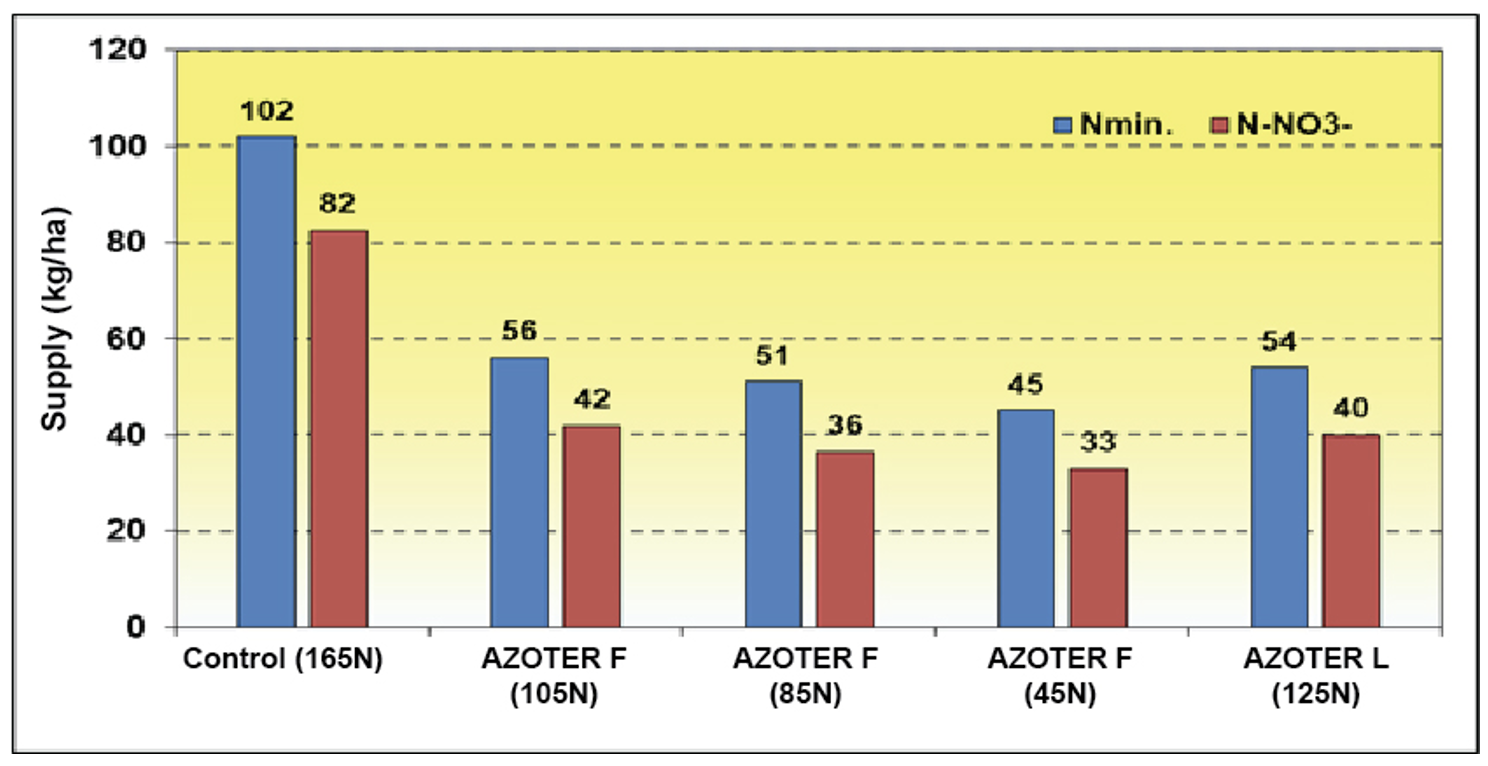
| Need for fertilizing N (kg/ha) to 8.7.: | Control (165N) | AZOTER F (105N) | AZOTER F (85N) | AZOTER F (45N) | AZOTER L (125N) |
| 8 kg N/ha | 54 kg N/ha | 59 kg N/ha | 65 kg N/ha | 56 kg N/ha |
Until harvest, Nmin supply in the soil was lower on variants, where AZOTER products were applied with suggested dose of nitrogen-sparing in fertilizers. The control variant with the application of a full nitrogen dose of 165 kg / ha showed the highest Nmin supply in the soil. At harvest the supply was low (13 kg / ha) on the control variant. On the variants with applied dose of nitrogen-sparing in fertilizers after AZOTER application, Nmin supply in the soil was very low (4 – 8 kg / ha). All variants, including the control, showed a very good use of nitrogen from the soil for yield formation. Nmin supply in the soil before fertilization and application of AZOTER preparations was 43 kg / ha. At the time of harvest, there was a significant decrease, ie the use of applied nitrogen, bound up from the air (N2) and possibly mineralized in the soil by maize stands (Graph 8).
Graph 8. Dynamics of mineral nitrogen content in the soil under maize stands with different levels of nitrogen fertilization after AZOTER products application
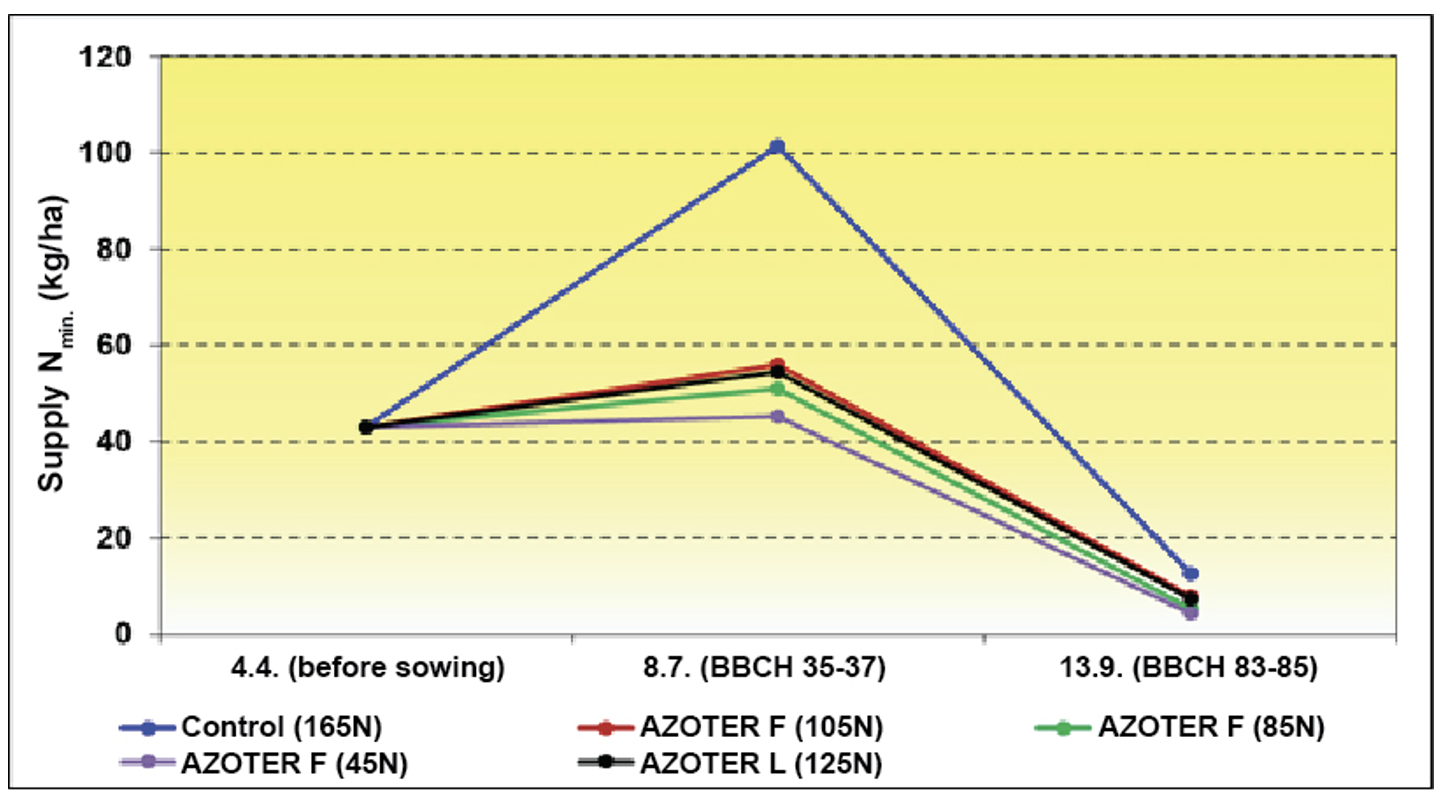
The application of AZOTER F to the soil was carried out just before the pre-sowing treatment of the soil on 15 April 2019. Before application, the soil was showing a slightly acidic pH, a suitable content of available phosphorus and potassium, a high content of calcium and magnesium. The maize crop was sown on 18 April and before sowing, liquid nitrogen DAM 390 fertilizer was applied in graded doses according to variants. After almost 5 months of vegetative period of maize, a significant change was found in the content of available nutrients and partly in the soil PH, compared to the state before the stand establishment. The available phosphorus content decreased significantly from a satisfactory (70 mg / kg) to low (33 mg / kg) and to very low (25 mg / kg) level. It is evident that AZOTER F application reduced the decrease of available phosphorus content in comparison with the control, where a very low content occurred at the end of the vegetation. Decrease of available potassium wasn´t observed. In contrast, after the application of full dose of nitrogen on the control plot, there was increase from 113 mg / kg to 167 mg / kg. After application of AZOTER F with a lower nitrogen dose of 105 kg N / ha, the potassium content increased to 149 mg / kg. The content of available calcium decreased after applying AZOTER F preparation. After the application of the full dose of nitrogen, there was a slight release of calcium compared to the state before the stand establishment. The content of available magnesium increased after the application of the full dose of nitrogen on the control even after the reduced dose of nitrogen together with AZOTER F preparation (Table 6).
| Term/variant | pH | P | K | Ca | Mg |
| CaCl2 | Content in mg/kg of soil | ||||
| Before sowing /aplication of fertilizer and AZOTER products on 4. 4. 2019 | 6,49
Slightly acidic |
70
Satisfactory |
113
satisfactory |
4062
high |
214 good |
| The end of vegetative period 13. 9. 2019 | |||||
| Control (165N) | 6,40 Slightly acidic |
25
Very low |
167
satisfactory |
4170
high |
257
good |
| AZOTER F (105N) | 6,63 neutral |
– | – | – | – |
| AZOTER F (85N) | 6,52
Slightly acidic |
33
low |
149
satisfactory |
3892
high |
269
high |
| AZOTER F (45N) | 6,40
Slightly acidic |
– | – | – | – |
| AZOTER L (125N) | 6,40
Slightly acidic |
– | – | – | – |
Table 6. The effect of AZOTER F preparations and applied dose of nitrogen-sparing in fertilizers on soil PH and on content of available nutrients in soil (in leachate according to Mehlich III)
Average plants from individual plots
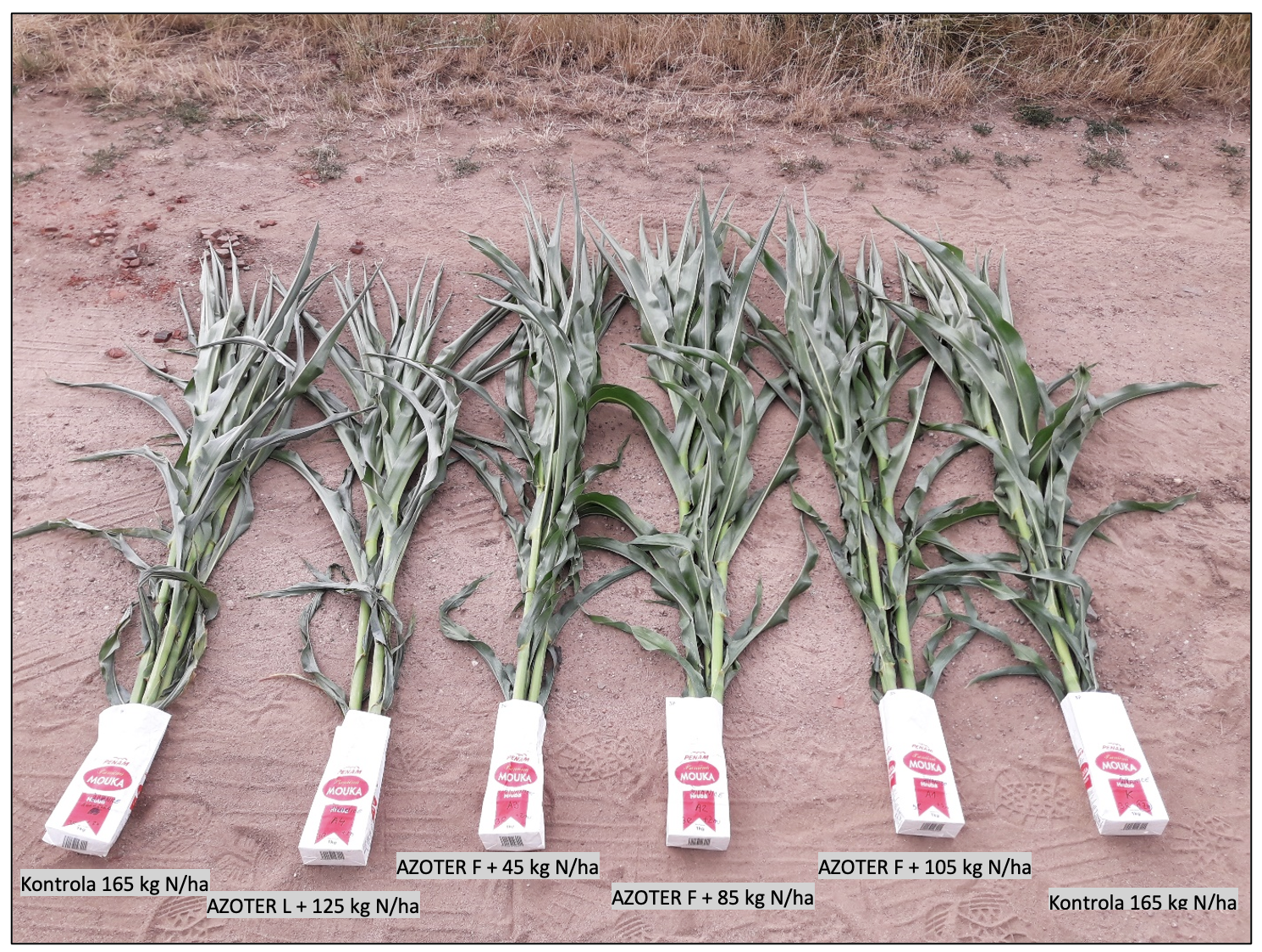
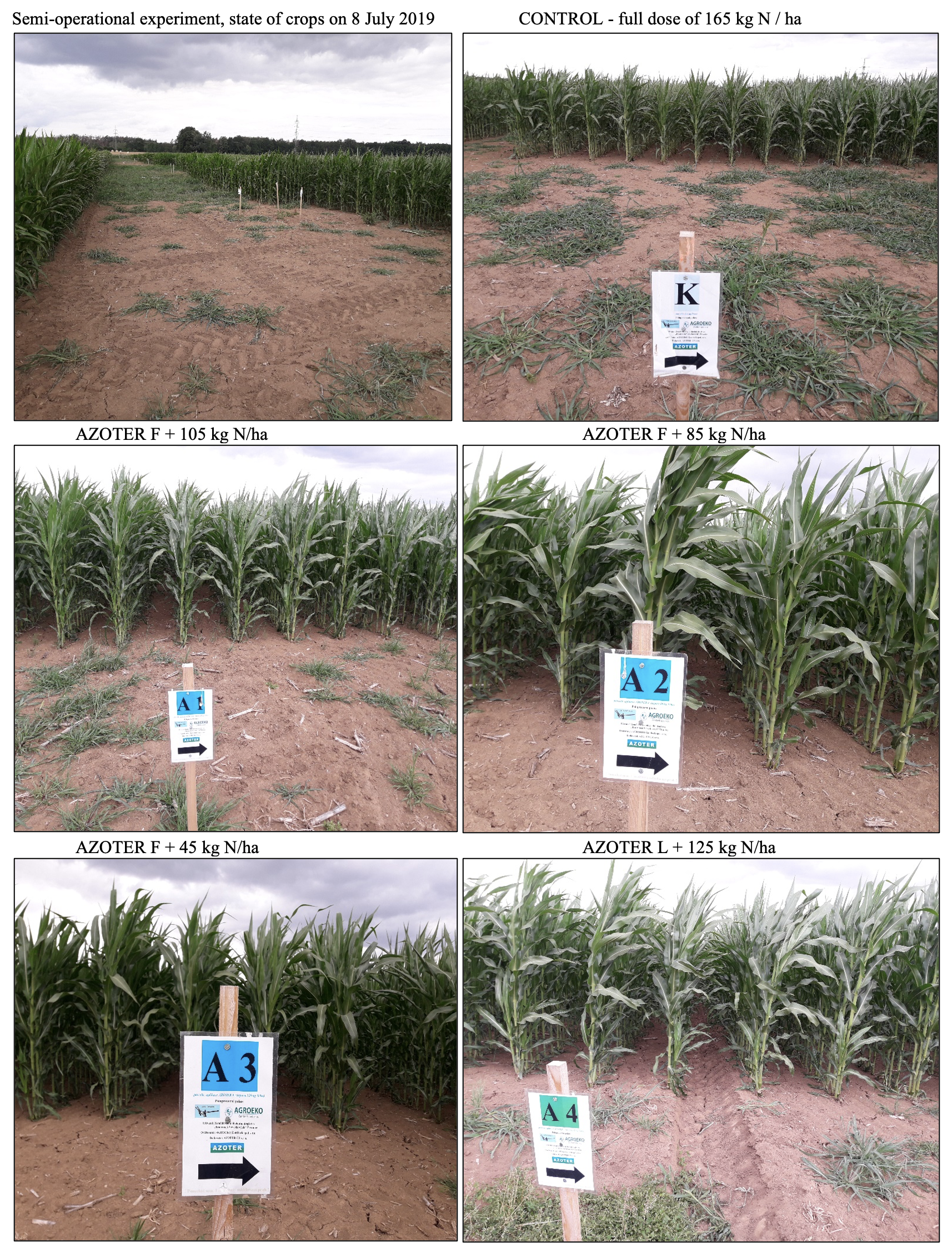
The plants showed different weight of aboveground biomass during the period of intensive growth. At the control variant with a full nitrogen dose of 165 kg N / ha, the dry matter weight of the aboveground biomass was 7.38 t / ha. After AZOTER F application together with a reduced dose of nitrogen in fertilizers to 105 kg / ha, the weight of aboveground biomass was 8.40 t / ha. Application of nitrogen in a medium reduced dose of 85 kg / ha after AZOTER F preparations, the weight of above-ground biomass was 8.74 t / ha. Applying the lowest nitrogen dose of 45 kg / ha after AZOTER F application, the weight of above-ground biomass reached 7.07 t / ha. AZOTER L application was carried out in the period from 7th to 8th leaf development on 20 June and when sowing maize with the addition of 125 kg N / ha in fertilizers. The evaluation of the vegetation and plant nutrient status was performed on the 18th day after the application and the plants showed the lowest weight of aboveground biomass of 6.05 t / ha. Growth depression was evident in the treated plants. In contrast, the application of AZOTER F to the soil showed a very good effect on the growth of aboveground biomass (Graph 9).
Graph 9. Dry matter weight of aboveground biomass of maize plants in intensive growth (BBCH 35-37, on 8 July)
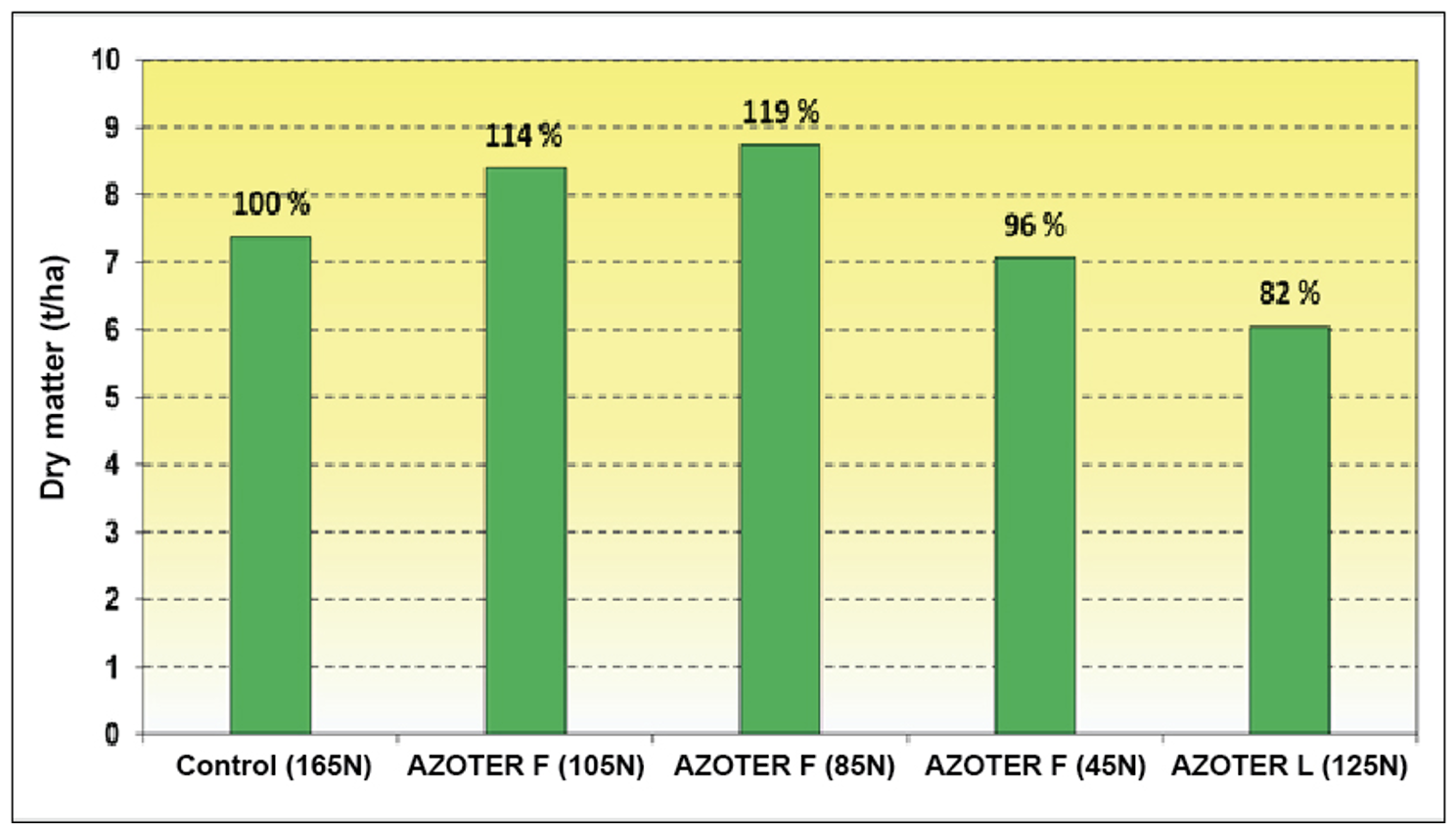
Plants in their intensive growth showed different growth stages and lengths. The highest increase was shown by the plants after applying AZOTER F preparation with the application of nitrogen in fertilizers in a moderately reduced dose of 85 kg N / ha. Nitrogen nutrition of the plants was the best (in slight deficit) after AZOTER L application, but the plants were small, and their growth was delayed. Nitrogen nutrition after AZOTER L application was rather concentrated in aboveground biomass and waited for its use in the growth of the stem and new leaves.
The worst nitrogen nutrition at the level of deep deficit was after applying a dose of 45 kg N / ha in fertilizers after the previous AZOTER F application. The medium level of nitrogen nutrition (medium deficit) was after AZOTER F application with addition of 85 and 105 kg N / ha. In the control variant with a full dose of nitrogen, nitrogen nutrition was at a higher level (mild deficit). On the variant with a dose of 85 kg N / ha with AZOTER F application, phosphorus nutrition was in a very deep deficit. On the control without AZOTER F application and on the variant after applying 105 kg N / ha in fertilizers together with AZOTER F fertilizer, the nutrition was in a deep deficit. Similarly, to that was observed after AZOTER L application. The best phosphorus nutrition at the level of deep deficit was after the application of a small dose of 45 kg N / ha with AZOTER F application. Potassium nutrition was at the level of very deep deficit at the variant with the dose of 105 kg N / ha with AZOTER F application. The deep deficit was observed on other variants, including control. Calcium nutrition was from deep to moderate deficit. The best calcium nutrition was on the control.Magnesium nutrition showed a slight deficit on control plot and at other variants had the medium deficit. Zinc nutrition showed a medium deficit on control and on other variants had a deep deficit. In summary, the best plant nutrition in the middle of intensive growth was on the control variant with the application of the full dose of 165 kg N / ha without applying AZOTER preparations. The second-best nutrition was observed in plants after AZOTER L application, but there was a low level of plant growth and consequently with lower dry matter weight (Table 7).
| Treatment | Phenobase(BBCH) | Lenght of plants (cm) | Dry matterof plants 100 pc. (g) | N (%) | To optimum (%) | P (%) | To optimum (%) | K (%) | To optimum (%) | Ca (%) | To optimum (%) | Mg (%) | To optimum (%) | Zn (mg/kg) | To optimum (%) |
| Control (165N) | 37 | 195 | 86,87 | 2,02 | 88 | 0,18 | 60 | 1,19 | 60 | 0,46 | 77 | 0,28 | 93 | 36,3 | 73 |
| AZOTER F (105N) | 37 | 195 | 98,87 | 1,75 | 76 | 0,18 | 60 | 1,03 | 52 | 0,42 | 70 | 0,25 | 83 | 31,2 | 62 |
| AZOTER F (85N) | 37 | 210 | 102,87 | 1,76 | 77 | 0,17 | 57 | 1,24 | 62 | 0,39 | 65 | 0,23 | 77 | 28,6 | 57 |
| AZOTER F (45N) | 36 | 210 | 83,23 | 1,71 | 74 | 0,20 | 67 | 1,36 | 68 | 0,42 | 70 | 0,24 | 80 | 30,5 | 61 |
| AZOTER L (125N) | 35-36 | 180 | 71,23 | 2,06 | 90 | 0,19 | 63 | 1,28 | 64 | 0,40 | 67 | 0,25 | 83 | 33,7 | 67 |
Table 7. Nutritional status of maize plants during the period of intensive growth on 8. 7.
The more detailed evaluated nitrogen intake of aboveground maize biomass showed negligible differences between the control where AZOTER application wasn´t used and only with full dose 165 kg N / ha and the variant with reduced nitrogen 105 kg / ha with AZOTER F application. Here the nitrogen intake was the highest in the range 147 – 154 kg / ha depending on variants. After AZOTER F application, a decrease in nitrogen intake to 121 kg / ha was observed on the plot with a low nitrogen dose of 45 kg N / ha in fertilizers. A similar intake of 125 kg N / ha was observed after AZOTER L application during vegetation period, although it was applied before sowing (125 kg N / ha) in fertilizers. Phosphorus intake was the highest (15 kg / ha) on variants with AZOTER F application and with the nitrogen dose of 105 and 85 kg / ha in fertilizers. The medium phosphorus intake of 13 – 14 kg / ha was at the control and after AZOTER F application of 45 kg N / ha. The lowest phosphorus intake of 12 kg / ha was after AZOTER L application. Also, potassium intake varied according to variants. The highest potassium intake of 108 kg / ha was after AZOTER F application with a dose of 85 kg N / ha. After applying a lower dose of 45 kg N / ha, the intake was 96 kg / ha. Potassium intake in the narrow range of 87 – 88 kg / ha was on the control and after AZOTER F application. After applying AZOTER L, the potassium intake was the lowest (78 kg / ha). Calcium intake showed a similar trend as phosphorus in the narrower range of 24 – 35 kg / ha. Magnesium intake was in the range of 15 – 21 kg / ha. The lowest magnesium intake was after AZOTER L application, and the highest one was observed on the control and after applying AZOTER F with addition of 105 kg N / ha (Graph 10).
Emergence of plant stand in AZOTER 2019 experiment
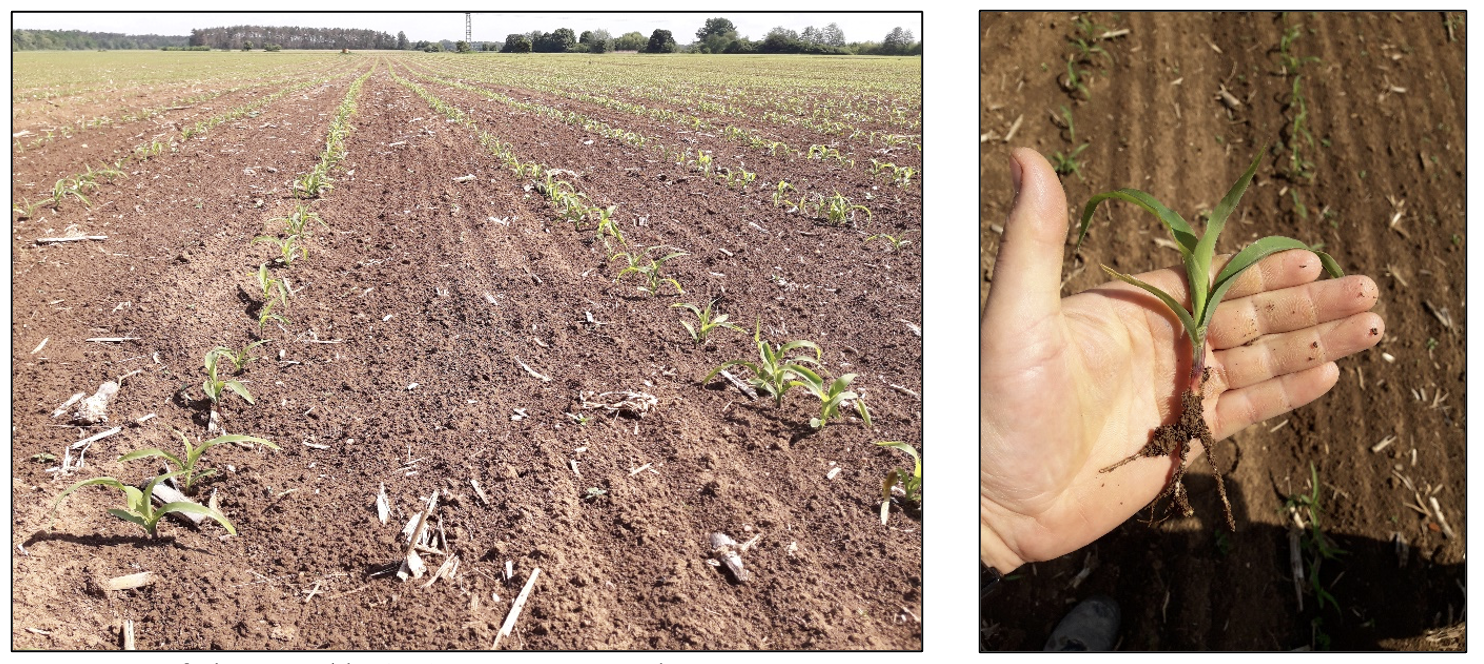
Graph 10. Biological nutrient intake by above-ground maize biomass in the intensive growth on 8 July (BBCH 35 – 37)
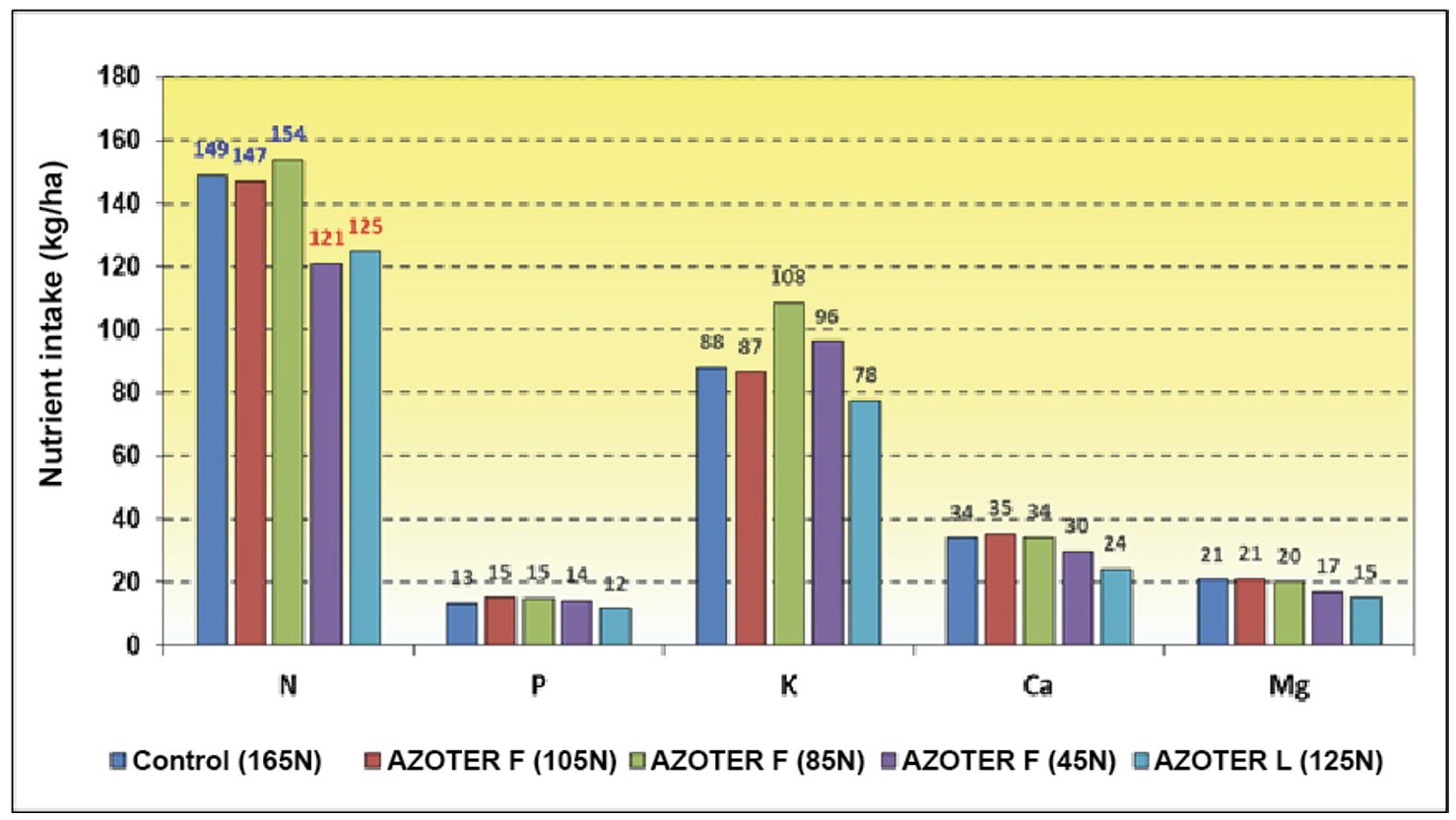
The plant stands on the control variant with the application of a full nitrogen dose of 165 kg / ha provided a yield of fresh forage of 43.93 t / ha in terms of an optimal dry matter content of 32%. After AZOTER F application with addition of a reduced dose of nitrogen in fertilizers to 105 kg / ha, a forage yield of 41.02 t / ha was observed. After application of a moderately reduced nitrogen dose to 85 kg / ha after AZOTER F application, a comparable forage yield of the control variant of 43.74 t / ha was observed. After applying a significantly reduced dose of nitrogen in fertilizers to 45 kg / ha that was after AZOTER F application, a yield of 43.46 t / ha was observed. After AZOTER L application, during vegetation period, with the addition of 125 kg N / ha before sowing, the plant stand showed the lowest yield of 38.64 t / ha.
The potential forage yield from plant sampling at harvest was different from the achieved yield from the harvested area, especially with AZOTER F product. The potential yield of fresh forage in average of 66.32 t / ha was established on the control variant. After AZOTER F application with addition of 105 kg N / ha in fertilizers, the forage yield was specified to be 69.24 t / ha. After application of a reduced nitrogen dose to 85 kg / ha with AZOTER F application, a yield of 60.26 t / ha was specified. The significantly reduced nitrogen dose to 45 kg / ha in fertilizers together with AZOTER F application showed the highest yield potential of 72.12 t / ha. On the contrary, the lowest yield potential of 56.43 t / ha was after AZOTER L application with addition of nitrogen dose of 125 kg / ha before sowing. The yield result from the total mechanized harvest and harvested plants was the same for AZOTER L. After this treatment, the plants did not flourish and had the lowest yield (Graph 11).
Nitrogen uptake of forage yield was the lowest on the control variant (167 kg / ha). After AZOTER F application with addition of 105 and 85 kg N / ha in fertilizers, the plant stand took 187 kg N / ha. After AZOTER F application with addition of 45 kg N / ha and after AZOTER L application with addition of 125 kg N / ha, the nitrogen uptake was 177 kg / ha.
Graph 11. The effect of AZOTER application on the fresh forage yield at the standard dry matter content (32% ) (September 20)
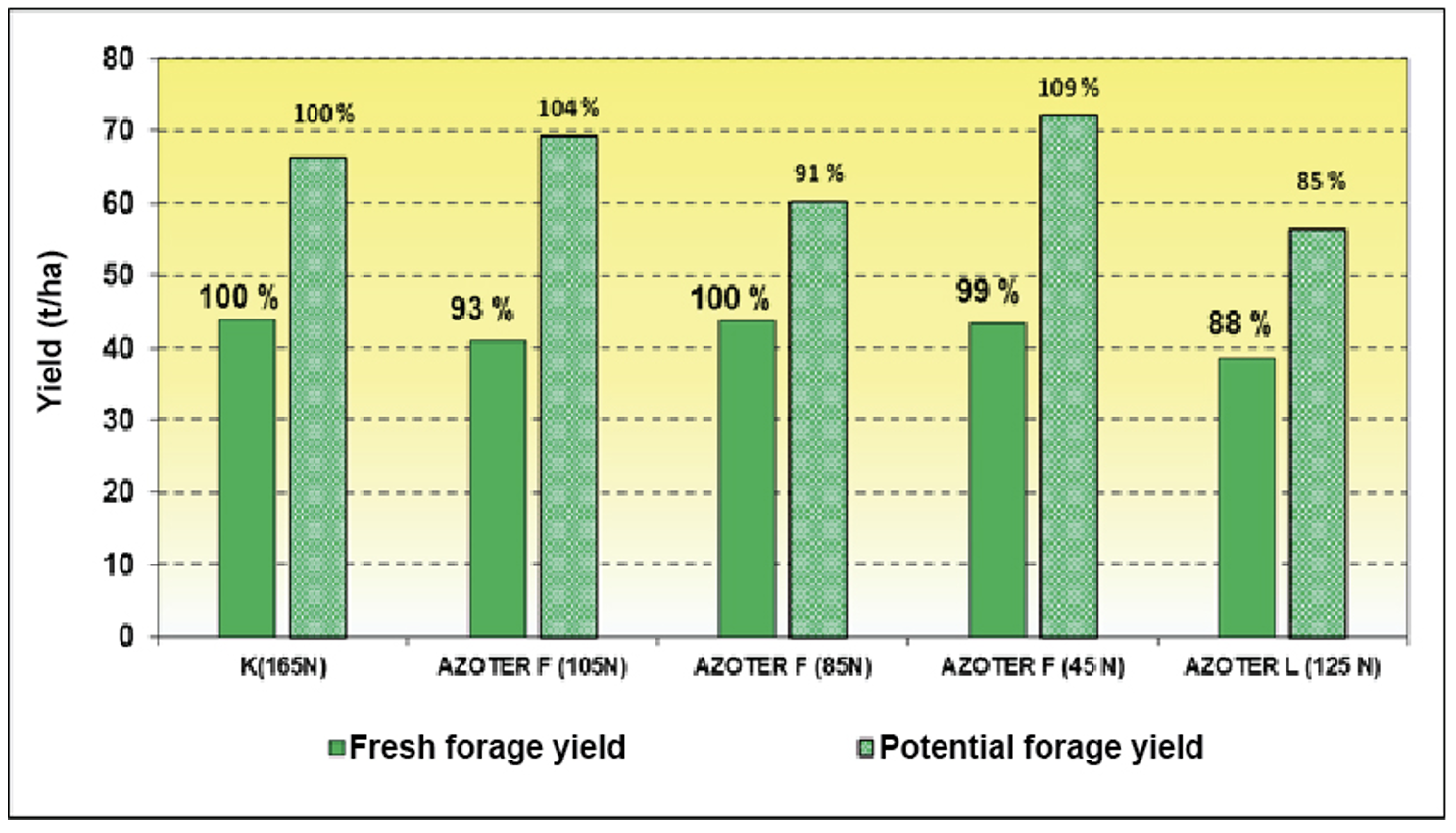
| Nitrogen uptake at harvest | |||||
| K (165N) | AZOTER F (105N) | AZOTER F (85N) | AZOTER F (45 N) | AZOTER L (125 N) | |
| kg N/ha | 167 | 187 | 187 | 177 | 177 |
| kg N/t forage | 4,6 | 5,7 | 4,9 | 5,5 | 5,5 |
| normative kg N/t | 3,5 – 4,0 | 3,5 – 4,0 | 3,5 – 4,0 | 3,5 – 4,0 | 3,5 – 4,0 |
The forage yield was mainly formed by the length of the plants in the harvest. On the control variant with the application of a full dose of nitrogen of 165 kg / ha, the average length of the plants was 230 cm with a gross proportion of the weight of the sticks of 41% in the weight of the whole plant. The density of grains on the cob was higher and the thousand grain weight was high (486 g), which corresponded to the high starch content in the forage. On the plot with a reduced nitrogen dose to 105 kg / ha in fertilizers and with AZOTER F application, an average plant length of 235 cm was observed and percentage of gross weight in forage was 42%. The number of grains on the cob was higher and the average thousand grain weight TGW reached 427 g and a high starch content was also observed. Application of AZOTER F products together with a reduced dose of nitrogen to 85 kg / ha in fertilizers showed a plant length of 225 cm with a gross share of the cob weight of 36% in the weight of the forage. The density of grains was medium and TGW was high (463 g). After applying a low dose of nitrogen (45 kg / ha) in fertilizers and AZOTER F application, the length of the plants was 222 cm with a percentage of gross cobs weight of 36%. The density of the cobs was medium and TGW was medium to higher (444 g). Application of AZOTER L during the vegetation at the 7th – 8th leaf stage showed the shortest plants with a diameter of 202 cm and percentage of gross weight of the cobs in the forage was only 31%. Density of the cob was low and the TGW was high (466 g) (Table 8)
| Variant treatment | Lenght of the plants | Cob | Fresh matter weight | Cob | TGW | ||
| Whole plant | Cob defoliation | Rows of grains | No. of grains in a row | ||||
| cm | pcs/plant | g | g | pcs | pcs | g | |
| Control (165N) | 230±15 | 1,0 | 640 | 262±38 | 17,1±1,5 | 30±5 | 486±4 |
| AZOTER F (105N) | 235±14 | 1,0 | 654 | 271±40 | 17,3±1,7 | 32±4 | 427±5 |
| AZOTER F (85N) | 225±17 | 1,0 | 612 | 222±63 | 16,2±2,5 | 26±8 | 463±5 |
| AZOTER F (45N) | 222±22 | 1,0 | 626 | 223±81 | 16,7±2,0 | 26±8 | 444±3 |
| AZOTER L (125N) | 202±16 | 1,0 | 554 | 171±64 | 14,7±2,4 | 22±7 | 466±7 |
Table 8. Effect of AZOTER application on yield-forming elements of maize forage
The achieved starch yield at the control variant was 6.04 t / ha (100%). After AZOTER F application with addition of a lower dose of nitrogen (105 kg / ha), a yield of 5.41 t / ha (90%) was observed. A reduced nitrogen dose to 85 kg N / ha with AZOTER F application gave a starch yield of 4.05 t / ha (67%). After a dose of 45 kg/N, a yield of 5.65 t / ha(94%) was observed. AZOTER L application with addition of nitrogen dose of 125 kg / ha gave the lowest yield of 3.80 t / ha (63%). The achieved yield of crude fiber in forage was 2.00 t / ha (100%) at the control variant. After AZOTER F application with addition of 105 kg N / ha, the yield was 1.79 t / ha (90%). After AZOTER F application with addition of 85 kg N / ha, the yield was 2.39 t / ha (120%) and with the applied dose of 45 kg N / ha, the yield reached 1.96 t / ha (98%). Application of AZOTER L with addition of 125 kg N / ha gave the fiber yield of 2.05 t / ha (103%). The yield of nitrogenous substances (NL) was 1.04 t / ha (100%) at the control variant. After AZOTER F application with addition of 105 and 85 kg N / ha, a yield of 1.17 t / ha (113%) was observed. After application of a reduced nitrogen dose to 45 kg N / ha with AZOTER F application and after AZOTER L application during vegetation with addition of 125 kg N / ha, the yield of nitrogenous substances was 1.11 t / ha (106%).
The potential for starch yield in fresh forage from harvested plant samples at harvest was determined to be 9.13 t / ha on a control plot. After AZOTER F application with addition of 105 kg N / ha, the yield was determined to be 8.75 t / ha, after the dose of 85 kg N / ha a decrease to 5.57 t / ha was observed and after the dose of 45 kg N / ha the yield was the highest (9.37 t / ha). After AZOTER L application with addition of 125 kg N / ha, the yield was determined to be 5.54 t / ha. The potential of fiber yield in the forage was determined to be of 3.32 t / ha at the control. After AZOTER F application with addition of 105 kg N / ha, the yield was determined to be 3.01 t / ha, after the dose of 85 kg N / ha the yield was determined to be 3.30 t / ha and after the dose of 45 kg N / ha the yield was determined to be 3.30 t / ha. After AZOTER L application, during the vegetation period with addition of 125 kg N / ha, the fiber yield was determined to be 3.00 t / ha. The potential yield of nitrogenous substances was determined to be 1.73 t / ha at the control without the application of AZOTER preparations. After AZOTER F application with addition of 105 kg N / ha the yield was 1.97 t / ha, after the dose of 85 kg N / ha, the yield was 1.61 t / ha and after the dose of 45 kg N / ha the yield was 1.83 t / ha.After AZOTER L application with addition of 125 kg N / ha, the yield was determined to be 1.62 t / ha (Graph 12).
Graph 12. The effect of AZOTER products on the yield of basic quality components of forage (September 20)
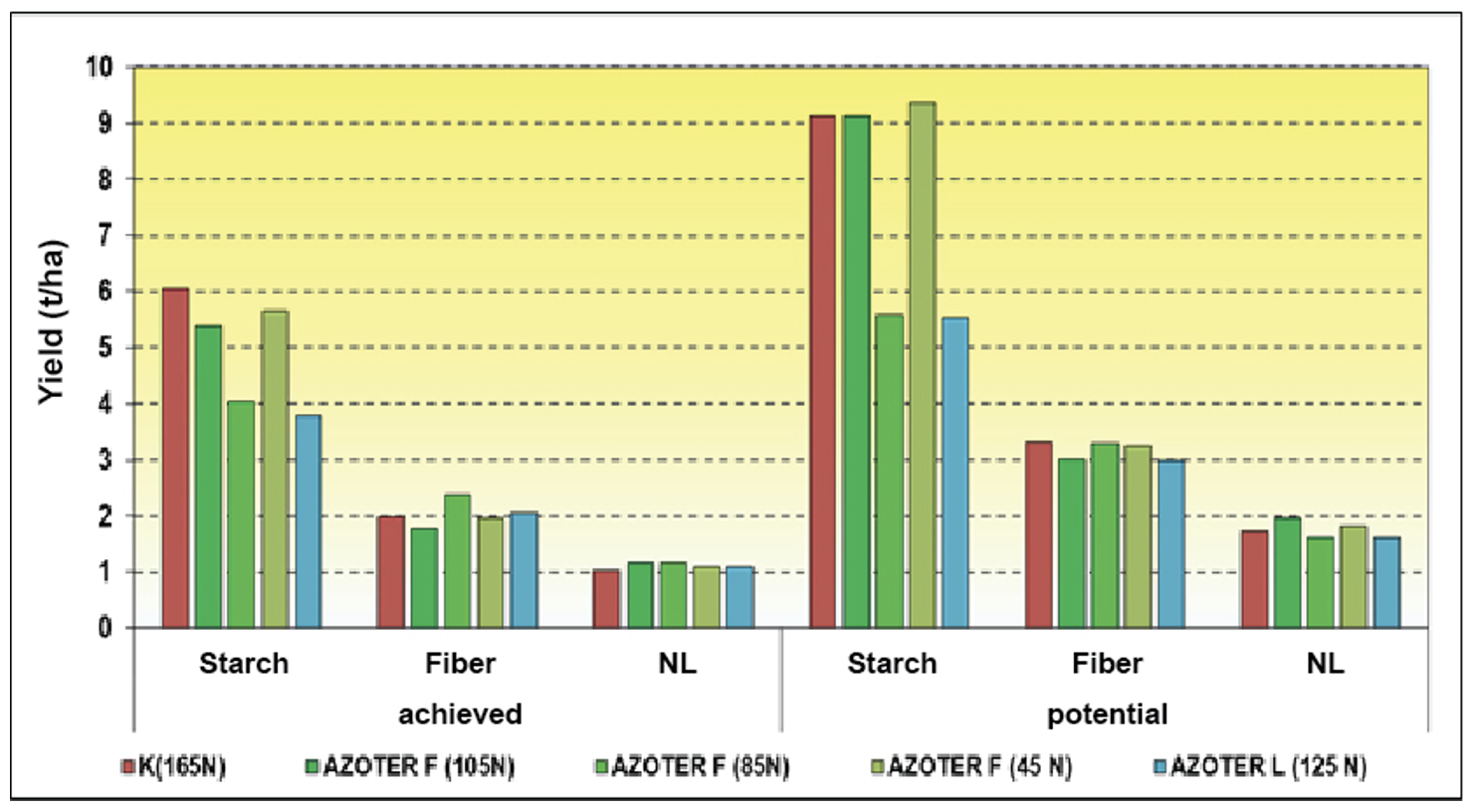
Due to the preservation, the dry matter content in the forage was the most suitable after AZOTER F application, with addition of a lower nitrogen dose of 85 kg / ha. Very high dry matter content (over 40%) was after AZOTER F application with addition of 45 kg N / ha. Other variants showed an increased optimal dry matter content, especially for a higher starch content. The starch content was optimal after AZOTER F application with addition of 85 kg N / ha in fertilizers and after AZOTER L application during vegetation period with addition of 125 kg N / ha. The starch content was very high on the control plots and after AZOTER F application with a nitrogen dose of 105 kg / ha. Very high starch content has already reduced the preservation of the forage. The crude fiber content was adequate on all variants. The content of nitrogenous substances in forage was the lowest (7.41%) on the control variant without applying AZOTER preparations. The second lowest content of nitrogenous substances was after the application of a low dose of nitrogen (45 kg / ha) with AZOTER F application. On the other variants, the content of nitrogenous substances was optimal. The content of slightly soluble sugars was low at the control variant without the application of AZOTER preparations and on the contrary, there was a very high content after AZOTER F application with addition of 85 kg N / ha. Other variants showed optimal sugar content for quality preservation. Overall, the plants had good conditions for assimilation and transformation of sugars (Table 9).
| Crop plant | Content (%) | ||||
| Dry matter | Starch | Fibre | N-substances | Sugars | |
| K (165N) | 39,01 | 43,00 | 14,20 | 7,41 | 4,50 |
| AZOTER F (105N) | 39,86 | 41,20 | 13,60 | 8,91 | 6,70 |
| AZOTER F (85N) | 37,07 | 28,90 | 17,10 | 8,34 | 12,20 |
| AZOTER F (45N) | 43,37 | 40,60 | 14,10 | 7,95 | 7,40 |
| AZOTER L (125N) | 38,35 | 30,70 | 16,60 | 8,97 | 9,60 |
| Optimum | 32 – 34 | 28 – 30 | <21 – 23 | 8 – 10 | 5 – 10 |
Tab. 9. The effect of the application of AZOTER products on the quality of maize forage (September 20)
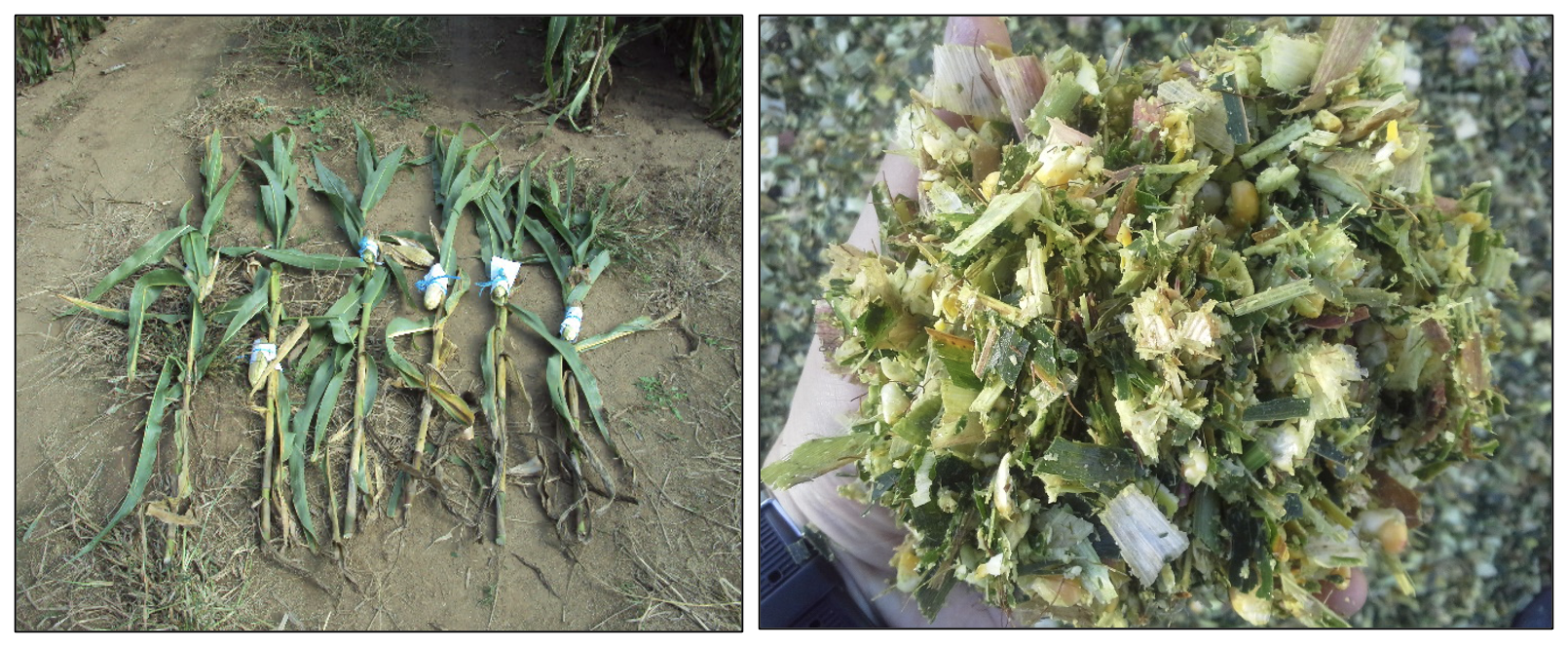
Economic evaluation: The valuation of the achieved forage yield in the current internal agricultural producers’ prices was set for CZK 21,964 / ha at the control variant with the application of a full nitrogen dose of 165 kg / ha (variant without the application of AZOTER products). After considering the cost savings of CZK 1,080 / ha for nitrogen fertilization in a reduced dose of 105 kg N / ha and considering the costs for AZOTER F application (CZK 900 product + CZK 200 application), an internal valuation of CZK 20,490 / ha (-7%) was achieved.
After AZOTER F application with addition of a reduced nitrogen dose to 85 kg / ha (cost saving of CZK 1,440 / ha), an internal valuation of CZK 22,210 / ha (+ 1%) was achieved. After AZOTER F application with addition of a significantly reduced dose of nitrogen to 45 kg / ha (saving in fertilization of CZK 2,160 / ha), a yield value of CZK 22,791 / ha (+ 4%) was achieved. After AZOTER L application during the vegetation period with nitrogen application of 125 kg N / ha (saving CZK 720 / ha), the the achieved valuation of the production was CZK 18,940 / ha (-14%) (Graph 13).
Graph 13. Comparison of the net internal price (crop production sales) of produced maize forage after different intensity of nitrogen fertilization and after application of AZOTER products
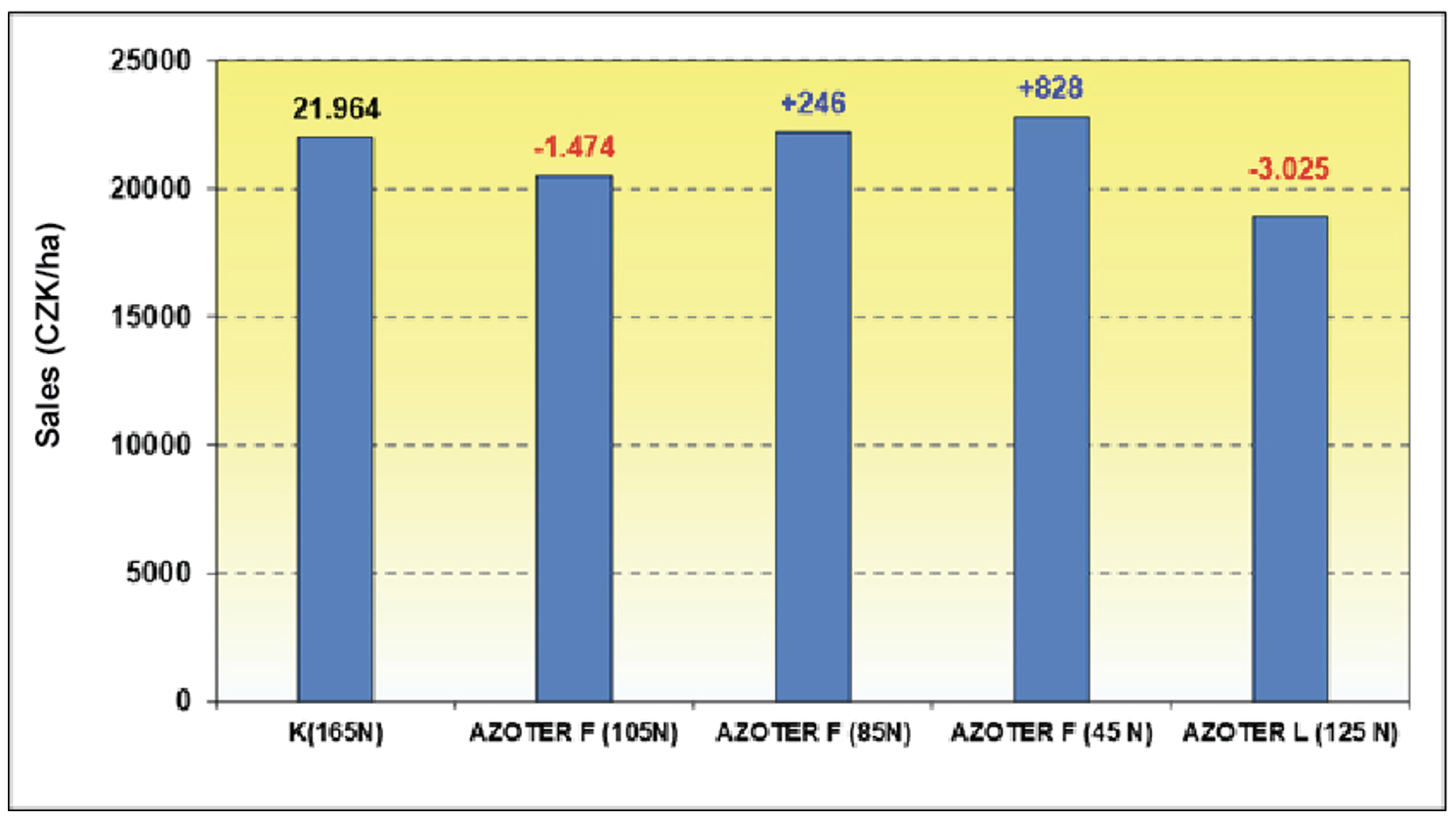
Note: Net internal price = gross internal price (CZK 500 / t of forage in fresh matter) after deducting the costs for the application of AZOTER products and after including the savings in nitrogen fertilization (1 kg N = CZK 18) in variants with AZOTER application.
| Variant treatment | Internal price (CZK/ha) | Direct costs for plant stand fertilization | |||
| Application of N fertilizers (CZK/ha) | AZOTER application (CZK/ha) | Application in total (CZK/ha) | A total for 1 t of forage (CZK) | ||
| K (165N) | 21964 | 2970 | 0 | 2970 | 68 |
| AZOTER F (105N) | 20510 | 1890 | 1100 | 2990 | 73 |
| AZOTER F (85N) | 21871 | 1530 | 1100 | 2630 | 60 |
| AZOTER F (45N) | 21732 | 810 | 1100 | 1910 | 44 |
| AZOTER L (125N) | 19320 | 2250 | 1100 | 3350 | 87 |
Conclusion
The application of AZOTER F bacterial preparation before sowing the winter wheat and maize, showed the effective nitrogen fertilizer savings. In biologically active soils with regular maintaining of the soil structure by suitable soil tillage and with the supply of organic matter (including stable fertilizers), economically efficient spring dose of 80 kg N / ha for winter wheat can be calculated.
For plant stands of maize for silage, fertilization can be reduced by a dose of 80 – 120 kg N / ha after autumn application of manurer. In winter wheat, a comparable yield and quality of grain was achieved with a saving of 80 kg N / ha with a fully fertilized control, but with a benefit in sales of CZK 652 / ha. In maize for silage, a comparable yield and quality of forage with a fully fertilized control was achieved with savings of 80 – 120 kg N / ha. The benefit of AZOTER F application was 246 – 828 CZK / ha after considering the savings of nitrogen fertilization in the usual valuation of forage.For winter wheat or maize, AZOTER L bacterial fertilizer applied during vegetation did not prove the estimated benefit of savings when 40 kg N / ha in fertilizers to the soil was applied. The effect of the leaf treatment was short-term (within 10 – 14 days after its application) and it improved the current nutritional state of wheat and maize, especially in the period of drought stress.
Recommendations for the greatest benefit of AZOTER F technology:
- Plan to use it on the plot with a structural state of the soil, treated with plowing or deep chisel plowing and with a regular supply of organic matter.
- The best use of AZOTER F application is to carry it out in the cloudy weather with subsequent pre-sowing plowing (eg incorporation with a compactor) with a set depth of at least 5 cm, optimally 10 cm
- Application of AZOTER F in sunny and windy weather is necessary with immediate incorporation into the soil (in these cases it is advantageous to use a concentrate in the applicator located directly on the cultivator).
- The application of the adjusted dose of nitrogen for plant stands can be carried out in mineral (DAM 390, urea, etc.) or liquid organic fertilizers (slurry, digestate, etc.) with a minimum interval before applying AZOTER F and subsequently also after this application.
- Sowing the maize should be performed with applying a small dose of NP fertilizer (up to 20 kg N and up to 30 kg P2O5 / ha) under the seed bed.
- In maize stands, it is good to carry out inter-row cultivation (hoeing) in the period of the 6th – 8th leaf stage to maintain the optimal air and water regime of the soil.
- In Strip-Till systems for maize, it is advisable to apply AZOTER F during sowing (under the seed bed with a seed drill) and nitrogen fertilizers in the springtime during strip plowing (or when renewing the strip plows from autumn period).
- For winter wheat, it is advisable to apply AZOTER F as soon as possible in early period of autumn, optimally after the basic tillage (in advance of actual sowing date).
The results of the tested AZOTER preparations were obtained in 2019 from the established semi-operational experiments for the customer AZOTER CZ s.r.o. in selected agricultural holdings.
In Žamberk on October 9, 2019

